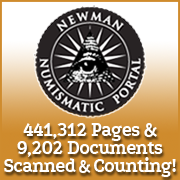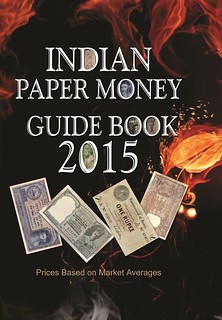
About UsThe Numismatic Bibliomania Society is a non-profit organization devoted to the study and enjoyment of numismatic literature. For more information please see our web site at coinbooks.org SubscriptionsThose wishing to become new E-Sylum subscribers (or wishing to Unsubscribe) can go to the following web page link MembershipThere is a membership application available on the web site Membership Application To join, print the application and return it with your check to the address printed on the application. Print/Digital membership is $40 to addresses in the U.S., and $60 elsewhere. A digital-only membership is available for $25. For those without web access, write to: Terry White, Treasurer AsylumFor Asylum mailing address changes and other membership questions, contact Terry at this email address: terrywhite5475@yahoo.com SubmissionsTo submit items for publication in The E-Sylum, just Reply to this message, or write to the Editor at this address: whomren@gmail.com
BUY THE BOOK BEFORE THE COIN |
- WAYNE'S WORDS: THE E-SYLUM NOVEMBER 13, 2016
- LINDA KOLBE, 1942–2016
- KOLBE & FANNING HOLDING WEEK-LONG 50% OFF SALE
- NEW BOOK: NUMISMATICS AND METAMORPHOSIS
- NEW BOOK: BANKING MODERN AMERICA
- HENRY MILLER COLLECTION REPRINT OFFERED
- WHITMAN JEFFERSON NICKEL FOLDER PRINTING PLATE
- NEWMAN PORTAL DIGITIZES BARNEY BLUESTONE SALES
- ANS ANNOUNCES 2017 GALA HONOREES
- MORE ON DIE TERMINOLOGY AT U.S. MINT
- ZACK STUDIES CONTEMPORARY COUNTERFEIT COINS
- NOTES FROM E-SYLUM READERS: NOVEMBER 13, 2016
- NEWARK SIEGE COIN DECORATES RUBBISH BIN
- W. ELLIOT WOODWARD PHOTO LOCATED
- VOCABULARY TERM: PLANCHET
- CHARLES PATTEN SHILLABER (1853-1911)
- BUILDING THE LILLY COLLECTION, CONTINUED
- 1933 DOUBLE EAGLE CASE MAY GO TO SUPREME COURT
- COLONIAL NOTE ADDED TO FORT MOULTRIE EXHIBIT
- VERY SPECIFIC MUSEUMS
- ARTICLE EXAMINES SATIRICAL HARD TIMES BANKNOTE
- 1875 ONE FIFTH OF A DOLLAR PATTERN
- THE CYRUS FIELD MEDAL
- MILWAUKEE GOLD CARNEGIE HERO MEDAL APPRAISED
- TUSKEGEE AIRMEN RECEIVE CONGRESSIONAL MEDALS
- WHO WILL BE THE NEXT U.S. MINT DIRECTOR?
- 2017 LIONS CLUBS DOLLAR FIRST STRIKE CEREMONY
- JEFF REICHENBERGER ON U.S. MINT PACKAGING
- STUDY EXAMINES BRITISH RARE COIN FINDS SINCE 1700
- ROMAN COIN HOARD UNEARTHED IN TOMARES, SPAIN
- COIN PLACED UNDER MERCHANT NAVY MONUMENT
- THE SCHOOL OF ENGRAVING
- MEDALS IN THE MORTON & EDEN DECEMBER 2016 SALE
- PDCA 2016 CURRENCY SALE HIGHLIGHTS
- THE ROYAL MINT'S NEW 12-SIDED £1 COIN
- NEW £1 COIN PROMPTS VENDING MACHINE UPDATES
- CHINA TO WITHDRAW 1 JIAO COINS
- INDIA SCRAPS 500 AND 1,000 RUPEE BANKNOTES
- RUPEE BANKNOTE BAN CAUSES PANIC
- NEW INDIAN BANKNOTES PRINTED IN SECRET
- NUMISMATISTS SCRAMBLE FOR DEMONETIZED RUPEES
- VENEZUELA HIRES CRANE CURRENCY FOR NEW NOTES
- GEORGIA RELEASES NEW 100 LARI BANKNOTES
- FAKE EURO NOTES FOUND IN BULGARIAN RESERVOIR
- NEW BOOK: THE CURSE OF CASH
- THE HISTORY OF BOOK CURSES
- ARTIST JOHNNY SWING'S PENNY CHAIR
- COOL BAR TRICK WITH NICKEL AND MATCHSTICK
- FEATURED WEB SITE: BANS
Click here to access the complete archive
To comment or submit articles, reply to whomren@gmail.com
WAYNE'S WORDS: THE E-SYLUM NOVEMBER 13, 2016
New subscribers this week include: Shaun Hughes, Jim Weber and Kendall Bailey. Welcome aboard! We now have 2,035 subscribers.
Tonight's issue is a whopper. Last week the Baltimore show and family events kept me from including several additional articles. This week the Veteran's Day holiday returned some time to me, and I've largely caught up. Enjoy.
This week we open with sad news about a pioneer of the Numismatic Bibliomania Society, followed by a great book sale, two new books, a coin folder discovery and a new auction catalog run for the Newman Numismatic Portal.
Other topics this week include the ANS Gala, die terminology at the early U.S. Mint, dealer W. Elliot Woodward, collector Charles Shillaber, 1799 cents, rare double eagles, Colonial and satirical Hard Times notes, gold medals for Cyrus Field and a Milwaukee Hero, the School of Engraving, the Royal Mint's new pound coin, and news from around the world about new and withdrawn coins and banknotes.
To learn more about the Grinnell collection, head dies, contemporary counterfeit coins, a coin-themed rubbish bin, the Battle of Fort Sullivan, Andrew Jackson in drag, dung beetle Benton, the Tuskegee Congressional Gold Medal, the East Florida Proclamation Medal, demonetized Rupees, the Curse of Cash and curses upon book thieves, read on. Have a great week, everyone!
Wayne Homren
Editor, The E-Sylum
LINDA KOLBE, 1942–2016
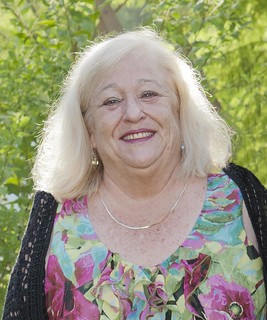 The first Secretary of the Numismatic Bibliomania Society, Linda Louise Kolbe,
passed away on Tuesday, November 8th, 2016. Born in Portland, Maine on July
31st, 1942, Linda moved to Pasadena, California at age 8. At a Chi-Rho Club
dance in 1960 at St. Andrew’s church hall, she met her future husband George.
The first Secretary of the Numismatic Bibliomania Society, Linda Louise Kolbe,
passed away on Tuesday, November 8th, 2016. Born in Portland, Maine on July
31st, 1942, Linda moved to Pasadena, California at age 8. At a Chi-Rho Club
dance in 1960 at St. Andrew’s church hall, she met her future husband George.
Several years later, the two entered the numismatic literature business in a small way, expanding their activities in the late 70s into a full-time enterprise. In the following years, Linda was an integral part of the business, handling much of the correspondence, paying bills, answering the telephone, proofreading catalogues and even stuffing them into mailing envelopes, among innumerable other activities. Above all, she imbued the business with a certain grace and kind spirit appreciated by all who knew her. Without her, George Frederick Kolbe Fine Numismatic Books would have been but a shadow of what it became.
A funeral Mass will be held on Tuesday, November 15th, at St. Andrew Church in Pasadena, California. May she rest in peace.
KOLBE & FANNING HOLDING WEEK-LONG 50% OFF SALE

Kolbe & Fanning Numismatic Booksellers have announced that they are holding a massive 50% off Inventory Reduction Sale, applicable to over 1400 books listed on their numislit.com website. The sale runs from Sunday, Nov. 13 through Saturday, Nov. 19, and is available only to orders placed through numislit.com.
Check out Kolbe & Fanning’s large online inventory of books, auction catalogues and periodicals on all aspects of numismatics from antiquity to the present. In addition to the 50% discount, orders totaling $100 or more receive free domestic shipping via media mail; orders over $300 receive free priority shipping (foreign orders shipped at cost). With over 1400 available titles, numislit.com has something for everybody!
THE BOOK BAZARRE
NEW BOOK: NUMISMATICS AND METAMORPHOSIS
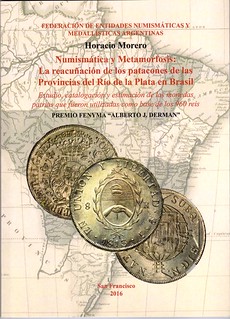 Title: “Numismática y Metamorfosis: La reacuñación de los patacones de las Provincias del Río
de la Plata en Brasil” (“Numismatics and Metamorphosis: the overstrike on the crowns of
Provincias del Río de la Plata in Brazil”).
Title: “Numismática y Metamorfosis: La reacuñación de los patacones de las Provincias del Río
de la Plata en Brasil” (“Numismatics and Metamorphosis: the overstrike on the crowns of
Provincias del Río de la Plata in Brazil”).
Author: Horacio Morero (ex president of Instituto Uruguayo de Numismática).
Edited by the Federación de Entidades Numismáticas y Medallísticas Argentinas (FENyMA) in Argentina.
Language: Spanish, 68 pages.
This study was the winner of the “Alberto J. (Coco) Derman” 2015 prize awarded by FENyMA.
Theme: this book is the first comprehensive study about the route, followed in Brazil, of the “patacones” (8 reales and 8 soles) of the Provincias del Río de la Plata struck in the Potosí mint in 1813 and 1815. Morero studies and catalogues the River Plate “patacones” that were used as host coin of the 960 reis struck in Brazil, in Bahia and Rio de Janeiro house mints. Also, he estimates the number of overstruck “patacones”, arriving to a very important conclusion: near 28% of the 1813 and 1815 mintage “disappeared” in Brazil (near 500,000 coins in relation to 1,800,000 coins minted in Potosi).
The first edition was released in August and is sold out.
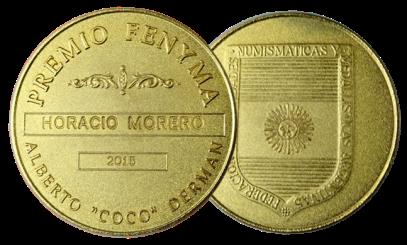
NEW BOOK: BANKING MODERN AMERICA
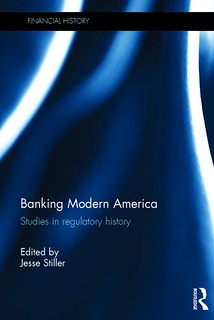 Banking Modern America: Studies in regulatory history
Banking Modern America: Studies in regulatory history
Edited by Jesse Stiller
© 2017 – Routledge
158 pages | 12 B/W Illus.
The passage of the National Currency Act of 1863 gave the United States its first uniform paper money, its first nationally chartered and supervised commercial banks, and its first modern regulatory agency: the Office of the Comptroller of the Currency. The law marked a milestone in the development of the U.S. financial system and the modern administrative state. Yet its importance has been largely overlooked.
Banking Modern America aims to address that gap. With its unique multidisciplinary approach that brings together scholars from disciplines including history, economics, the law, and finance, this book lends a new dimension to studying the origins and development of a system that touched key aspects of modern America. Chapters examine key episodes in the history of Federal banking, looking at the Civil War origins of the national banking system and the practical challenges of setting up a new system of money and banking. The essays in this volume explore the tensions that arose between bankers and Federal regulators, between governmental jurisdictions, and even between regulators themselves.
This book will be essential reading for academics of banking and finance, regulation, numismatics and history, as well as professional economists, historians and policy makers interested in the history of the US financial system.
Table of Contents
General Introduction
Jesse Stiller
Origins of the National Bank Act and National Currency
Peter Huntoon
National Bank Notes and the Practical Limits of Nationalization
Franklin Noll
Charter No. 1: First Among National Banks
Marianne Babal
E.T. Wilson and the Banks: A Case Study in Government Regulation and Service
Paula Petrik
Stabilizing the National Banking System, 1864-1913: The Role of Bank Examination
Eugene N. White
Founding the Fourth Branch: The Office of the Comptroller of the Currency
Jesse Stiller
National Bank Preemption and the Financial Crisis of 2008
Raymond Natter
The Measure of a Regulator: the Office of Thrift Supervision, 1989 – 2011
Paula Dejmek Woods
For more information, or to order, see:
Banking Modern America
(www.routledge.com/Banking-Modern-America-Studies-in-regulatory-history/Stiller/p/book/9781138213807)

HENRY MILLER COLLECTION REPRINT OFFERED
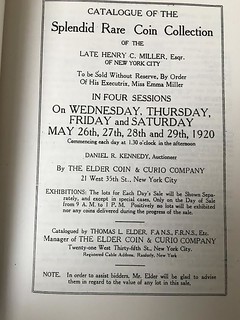
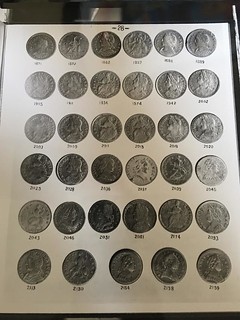
On offer are unbound reprints, with photographic plates
The image below is of the 1992 bound version
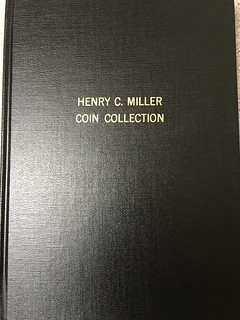 After an example appeared in the recent Kolbe-Fanning auction, I've gotten a few inquiries about a reprint I did nearly a quarter century ago for Thomas Elder's May, 1920 sale of the Henry Miller collection, which was superb in English, Roman and most important for US colonials. The reprint contains the entire text of the catalogue, 2212 lots on 154 pages, as well as the Prices Realized list and the bid sheet. There are 28 photographic plates, slightly reduced from the originals, but of really good quality, taken from a mint condition copy that had sat in the box it was mailed in and unopened since! These are actual photographic plates (from back in the days before digital photography!), not screened and printed plates, which means a glass will let you magnify the images without them breaking up into dots.
After an example appeared in the recent Kolbe-Fanning auction, I've gotten a few inquiries about a reprint I did nearly a quarter century ago for Thomas Elder's May, 1920 sale of the Henry Miller collection, which was superb in English, Roman and most important for US colonials. The reprint contains the entire text of the catalogue, 2212 lots on 154 pages, as well as the Prices Realized list and the bid sheet. There are 28 photographic plates, slightly reduced from the originals, but of really good quality, taken from a mint condition copy that had sat in the box it was mailed in and unopened since! These are actual photographic plates (from back in the days before digital photography!), not screened and printed plates, which means a glass will let you magnify the images without them breaking up into dots.
In checking my shelves, I noticed that I had five unbound sets left -- the full text and all 28 plates. The plates are untrimmed. The reprint, following the original, was bound in black cloth with the title in gilt; these are loose but will allow a collector to bind them either as the originals or to match any plated Elders they may already have in their library. These cost about $250 each to produce and mail -- and that was in 1992 dollars! If there are collectors in these areas who are interested in a set -- and don't want to pay the $5,000 or so that an original plated Miller would bring -- I will offer these last five at $125 each, postpaid. There will be no additional copies produced. I can be reached at rosaamltd@gmail.com .
WHITMAN JEFFERSON NICKEL FOLDER PRINTING PLATE
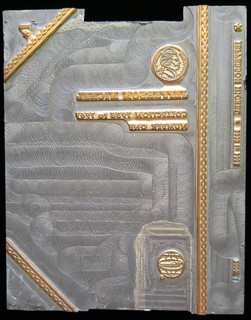
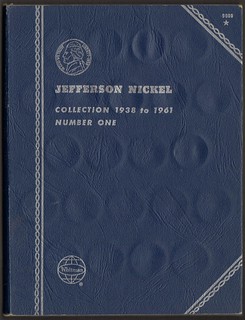
I'm attaching images of a printing plate that I recently acquired and an example of the printed folder. As the 1984 letter from Dick Yeo (aka R. S. Yeoman) explains, these plates were obsolete by then and were being sent to some of Whitman's better customers in thanks for their loyalty.
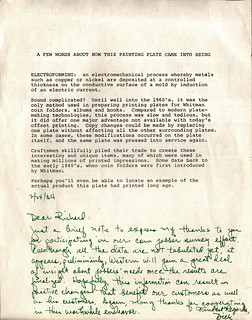 I already had two such plates from the Sixth Edition of Whitman folders (1965-67), but these are for Liberty Seated titles that were poor sellers, and I believe the plates were never utilized (I haven't found a match in 35 years of searching). This new one for Jefferson Nickels dates from the Eighth Edition (1968-78), and I actually have a folder of the same design. Whether this particular plate was the one that printed my copy is probably impossible to determine, but at least I can display the two side by side. Note that the plate includes the spine text, as that was the only other part of the cover that had any printing.
I already had two such plates from the Sixth Edition of Whitman folders (1965-67), but these are for Liberty Seated titles that were poor sellers, and I believe the plates were never utilized (I haven't found a match in 35 years of searching). This new one for Jefferson Nickels dates from the Eighth Edition (1968-78), and I actually have a folder of the same design. Whether this particular plate was the one that printed my copy is probably impossible to determine, but at least I can display the two side by side. Note that the plate includes the spine text, as that was the only other part of the cover that had any printing.
Needless to say, I'm a buyer of any such tools relating to the production of coin boards, folders and albums.
To visit Dave's CoinCollectingBoards web site, see:
http://www.coincollectingboards.com/

NEWMAN PORTAL DIGITIZES BARNEY BLUESTONE SALES
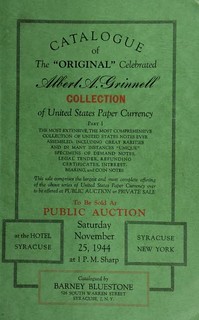 The Barney Bluestone auction sale catalog series, running from 1931 to 1950, consists of 109 numbered sales, plus eight additional catalogs presenting the Albert Grinnell paper money collection (1944 - 1947). These have been scanned from the ANS library, with Dan Hamelberg filling in gaps. Bluestone primarily handled U.S. material, with the Grinnell sales being the obvious highlight of his career.
The Barney Bluestone auction sale catalog series, running from 1931 to 1950, consists of 109 numbered sales, plus eight additional catalogs presenting the Albert Grinnell paper money collection (1944 - 1947). These have been scanned from the ANS library, with Dan Hamelberg filling in gaps. Bluestone primarily handled U.S. material, with the Grinnell sales being the obvious highlight of his career.
A sample search on “German National Bank, Covington” reveals paper money specimens issued by this Kentucky bank in the 1870s, from the Grinnell collection, along with search results from the Annual Report of the Comptroller of the Currency and the Report of the Secretary of the Treasury on the State of Finances. This is only one of thousands of such banks, but, with a large mass of digitized material, the odds of finding data on any particular institution are greatly increased.
Link to Barney Bluestone catalogs on NNP:
https://nnp.wustl.edu/library/auctioncompanydetail/17
ANS ANNOUNCES 2017 GALA HONOREES
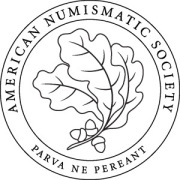 The American Numismatic Society (ANS) is pleased to announce that on Thursday, January 12, 2017, it will honor its esteemed patron Anthony J. Terranova with the Trustees’ Award at the Annual Gala at the Waldorf Astoria Hotel in New York City. The distinction of the Trustees’ Award will also be conferred upon the Eric P. Newman Numismatic Education Society and the Newman Numismatic Portal, which have been essential to the Society’s efforts to make its numismatic resources widely accessible online.
The American Numismatic Society (ANS) is pleased to announce that on Thursday, January 12, 2017, it will honor its esteemed patron Anthony J. Terranova with the Trustees’ Award at the Annual Gala at the Waldorf Astoria Hotel in New York City. The distinction of the Trustees’ Award will also be conferred upon the Eric P. Newman Numismatic Education Society and the Newman Numismatic Portal, which have been essential to the Society’s efforts to make its numismatic resources widely accessible online.
Anthony Terranova, ANS Life Fellow and Augustus B. Sage Society member, joined the Society 40 years ago. He was elected Fellow in 1992 and became a Life Fellow in 1995. He has been a member of the Sage Society since 2006. As a collector, dealer, and researcher in numismatics, he has greatly enhanced the ANS collections with many important donations to our numismatic cabinet, many books, archives and auction catalogues to the Harry W. Bass, Jr. Library, as well as many generous donations. The Society is delighted to acknowledge his exemplary devotion and commitment.
The Newman Numismatic Portal (NNP) is an online numismatic resource, sponsored by a grant from the Eric P. Newman Numismatic Education Society, which works with the ANS on a scanning project that enables greater access to American numismatic research material on both the ANS Digital Library and Newman Portal websites.
Past recipients of the Trustees’ Award include such notable numismatists and donors as Ms. Shelby White and Mr. Leon Levy, Mr. Jamie Stewart, Mr. Kenneth L. Edlow, Mr. George Kolbe, Mr. Q. David Bowers, Mr. Chester L. Krause, Mr. Donald G. Partrick, Mr. Harvey Stack, Mr. Victor England, Jr., Mr. Ira Goldberg, Mr. Larry Goldberg, Mr. Harlan J. Berk, Mr. Roger S. Siboni, Mrs. Marian Scheuer Sofaer and the Honorable Abraham D. Sofaer, Mrs. Elizabeth Forbes Hazard Scott and Mr. Stanley DeForest Scott, and Mr. and Mrs. John W. Adams.
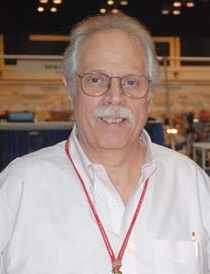 Anthony Terranova is a specialist in early American coinage whose interest in collecting began as a teenager in Brooklyn, with classic United States series. He is well known among early American collectors, not least for the invaluable input generated by his research. He is the recipient of the American Numismatic Association’s 2011 Farran Zerbe Memorial Award for distinguished service and the Professional Numismatist Guild’s Lifetime Achievement Award in 2006. He is a member of the New York Numismatic Club. The Anthony Terranova Collection of Counterstamped Coins sold at auction with Stack’s Bowers.
Anthony Terranova is a specialist in early American coinage whose interest in collecting began as a teenager in Brooklyn, with classic United States series. He is well known among early American collectors, not least for the invaluable input generated by his research. He is the recipient of the American Numismatic Association’s 2011 Farran Zerbe Memorial Award for distinguished service and the Professional Numismatist Guild’s Lifetime Achievement Award in 2006. He is a member of the New York Numismatic Club. The Anthony Terranova Collection of Counterstamped Coins sold at auction with Stack’s Bowers.
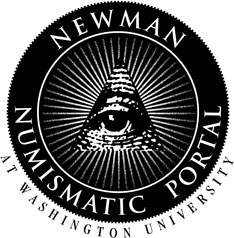 Administered through Washington University Libraries in St. Louis, the Newman Numismatic Portal has contracted with Internet Archive for the scanning operation at the ANS Library. Internet Archive is a non-profit organization dedicated to digital preservation of all media. The NNP, sponsored by a $2 million grant from the Eric P. Newman Numismatic Education Society to the Washington University Libraries, began operations in December 2014. It has digitized over 170,000 pages of ANS documents alone to date.
Administered through Washington University Libraries in St. Louis, the Newman Numismatic Portal has contracted with Internet Archive for the scanning operation at the ANS Library. Internet Archive is a non-profit organization dedicated to digital preservation of all media. The NNP, sponsored by a $2 million grant from the Eric P. Newman Numismatic Education Society to the Washington University Libraries, began operations in December 2014. It has digitized over 170,000 pages of ANS documents alone to date.
The ANS Library’s entire run of early American auction catalogs, which include those of Frossard, Woodward, Chapman, Elder, and other notable names in the field, were first to be scanned. Unique archival collections such as dealer and collector correspondence, housed in the ANS Library’s Rare Book Room, will also be scanned so they can be access on a large scale.
Every year the American Numismatic Society raises critical revenue through Gala ticket sales, program advertisements, sponsorships, contributions, and the proceeds from a live auction. These funds are used to further the Society’s mission of supporting research and education in numismatics.
For information on purchasing tickets or program advertisements, please contact Catherine DiTuri at 212-571-4470, ext. 117, membership@numismatics.org.
To read the complete press release, see:
The American Numismatic Society Announces 2017 Gala Honorees
(http://numismatics.org/Gala2017pr/)
To read the complete Coin World article, see:
Hendricksons build numismatic empire on silver
(www.coinworld.com/news/us-coins/2015/04/hendricksons-build-empire-founded-on-silver.all.html#)
THE BOOK BAZARRE
MORE ON DIE TERMINOLOGY AT U.S. MINT
Some interesting additions to lasts week's topic on "head die" terminology at the US Mint and in the Wiley-Bugert half dollar book. The usage of "head Die" to describe an obverse die was first recorded at the US Mint in December of 1794 by Chief Engraver Robert Scot in his draft engraving report to Congress. This report was mentioned by authors Don Taxay and Robert Hilt, and was first published in the August, 2012 John Reich Journal in my article "Robert Scot's Engraving Report to the Congressional Committee on the Mint."
Scot also used "reverse Die" and did not use "Tail Die." An excerpt of Scot's report follows, along with an image of the same section of the original report, courtesy of the National Archives and Records Administration, Record Group 104, Folder 14:
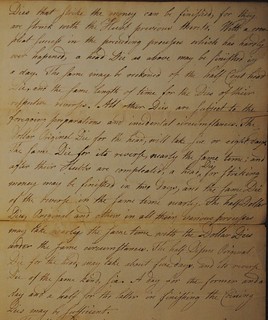 "With a compleat success in the preceeding processes which has hardly ever happened, a head Die as above may be finished in a day. The same may be reckoned on the half Cent head Die, and the same length of time for the Dies of their respective reverses. All other Dies are subject to the foregoing preparations and incidental circumstances. The dollar Original Die [now called master die] for the head, will take six or eight days. The same Die for its reverse, nearly the same time; and after the Hubbs are compleated, a head Die for striking money may be finished in two days, and the same Die of the reverse in the same time nearly. The half Dollar Dies, original and others in all their various processes may take nearly the same time with the Dollar Dies under the same circumstances. The half Disme Original Die for the head, may take about five days, and its reverse Die of the same kind, six. A day for the former and a day and a half for the latter in finishing the Coining Dies may be sufficient."
"With a compleat success in the preceeding processes which has hardly ever happened, a head Die as above may be finished in a day. The same may be reckoned on the half Cent head Die, and the same length of time for the Dies of their respective reverses. All other Dies are subject to the foregoing preparations and incidental circumstances. The dollar Original Die [now called master die] for the head, will take six or eight days. The same Die for its reverse, nearly the same time; and after the Hubbs are compleated, a head Die for striking money may be finished in two days, and the same Die of the reverse in the same time nearly. The half Dollar Dies, original and others in all their various processes may take nearly the same time with the Dollar Dies under the same circumstances. The half Disme Original Die for the head, may take about five days, and its reverse Die of the same kind, six. A day for the former and a day and a half for the latter in finishing the Coining Dies may be sufficient."
To read the earlier E-Sylum articles, see:
REGISTER OF DIES: HEADS AND TAILS
(www.coinbooks.org/esylum_v19n45a14.html)
NEW BOOK: ROBERT SCOT - ENGRAVING LIBERTY
(www.coinbooks.org/esylum_v18n33a04.html)
ZACK STUDIES CONTEMPORARY COUNTERFEIT COINS
The Baltimore Show was frankly more active than I had anticipated. After months of wearisome election battles and relentless revelations, it was nice to set that part of our lives aside and focus on buying and selling coins! The usual suspects were in attendance at the show, and everyone seemed to have a good time--collectors were generally able to secure desired pieces for their collections from the numerous dealers at the show.
One unexpected surprise was Winston Zack appearing at the show from far away San Diego, California! He shared numerous examples of contemporary counterfeit coins that are being used for his huge research project of documenting and writing a two (or more) volume book on these historic and often overlooked pieces of our numismatic history.
Some of the Seated coins--struck from hand cut dies created by now forgotten counterfeiters, were so comical in their crudity that I burst out laughing. Examining these folk art pieces captures so much of the American ingenuity spirit--that prior generations of people actually took the time to stamp out their own money with small common tools and whatever know-how and ability they had. These mom and pop enterprises continue all through our history, from the earliest colonial coins through our current coinage--one need look no further than the 1944 "Henning" Jefferson nickels, created and stamped out in a certain Mr. Henning's basement to be used to pay the hated toll on the New Jersey Turnpike!
Some of these counterfeiting operations were huge factories which churned out countless examples of these counterfeit coins. This is an area of research that simply has been overlooked for far too long, with the exception being the superlative work by Keith Davignon on Contemporary Counterfeit Capped Bust Half Dollars. Needless to say many numismatists have long awaited such a book documenting these fascinating coins.
To read the JR Newsletter online, see:
http://jr-newsletter.blogspot.com/
For more information on the John Reich Collectors Society, see:
http://jrcs.org/

NOTES FROM E-SYLUM READERS: NOVEMBER 13, 2016
The Eye by Shaun Hughes
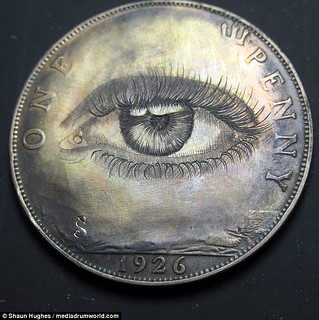
Regarding this engraved piece by Shaun Hughes, Larry Gaye writes:
WOW, what a great piece.
To visit our page on Facebook, see: https://www.facebook.com/Numismatic-Bibliomania-Society-144733835552745/
To read the earlier E-Sylum article, see:
ENGRAVED COINS OF SHAUN HUGHES
(www.coinbooks.org/esylum_v19n45a23.html)
A Gutenberg Quibble from Mike Marotta
Mike Marotta writes:
I found a small problem with “Happy Anniversary: Gutenberg’s Printing Press” (The E-Sylum Volume 19, Number 40, October 2, 2016, Article 25). The article was based on an NPR Writer’s Almanac for September 30, 2016. According to Garrison Keillor: “In 1440, Gutenberg wrote and printed copies of his own mysteriously titled book, Kunst und Aventur [Art and Enterprise], releasing his printing ideas to the public, and by 1450 his movable-type printing press was certainly in operation.”
Keillor inverted the title of Gutenberg’s book. Searching WorldCat and Google Scholar, the only citations are to Aventur und Kunst.
To read the earlier E-Sylum article, see:
HAPPY ANNIVERSARY: GUTENBERG'S PRINTING PRESS
(www.coinbooks.org/esylum_v19n40a25.html)
Tucker Donates Book to PAN
Pat McBride of the Pennsylvania Association of Numismatists writes:
A book donation from Whitman publisher and author Dennis Tucker made at the Fall PAN Show and Convention on Friday October 29th. This donation of his latest endeavor, American Gold and Silver: U.S. Mint Collector and Investor Coins and Medals, Bicentennial to Date is a quite the fine addition to our library. Dennis' presentation at our Lecture Series was very enlightening regarding these recent coins and medals produced by the mint.
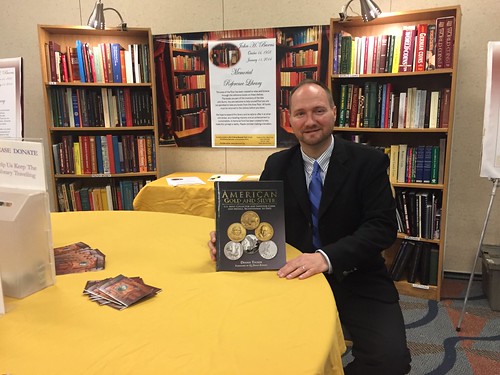
For more information on PAN, see:
http://pancoins.org/
An Old Racketeer Nickel?
Ken Bressett writes:
Another nice issue. I always enjoy them. Just for kicks I will pass along a picture of an 1883 nickel that I found in an old accumulation many years ago. It seems about as original as any "Racketeer Nickel" I have ever seen.
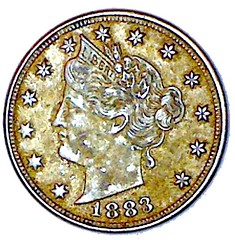
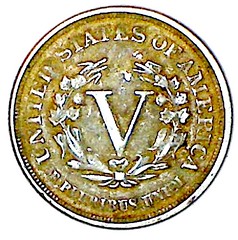
Ken writes:
I can’t vouch for the plating. It looks like some sort of a clumsy home-made job. And is what I would expect from a petty crook of that time. It definitely is not a professional job, but it does have a golden appearance. I suspect it was dipped into something like gold colored paint. Probably got put back into circulation after a while, or saved as a curiosity. I don’t think it is a modern concoction, and certainly is not one of the recent professionally plated jobs.
To read the earlier E-Sylum articles, see:
THE DEADWOOD RACKETEER NICKEL
(www.coinbooks.org/esylum_v19n44a28.html)
THOUGHTS ON THE DEADWOOD RACKETEER NICKEL
(www.coinbooks.org/esylum_v19n45a04.html)
Uncirculated 1799 Cent for $25
The CoinTalk contest question published last week asked:
In the 19th century, when coin collecting was just beginning to become popular, one of the most publicized American coin rarities was featured in advertisements and news items. For a long time, Ebenezer Locke Mason, Jr., stated that he would pay $25 for a nice one...
Pete Smith writes:
I am attaching a scan from Mason's Coin and Stamp Collector's Magazine of June. 1867, page 24. He offers to pay $25 for a cent of 1799.
In another item he says that he will pay $25 if the coin is in uncirculated condition. I doubt if there was an uncirculated 1799 cent known in 1867.
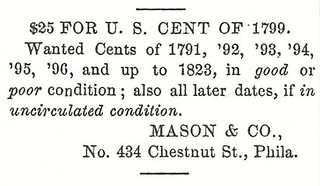
To read the earlier E-Sylum article, see:
COINTALK COIN CONTEST GIVEWAY CHALLENGE
(www.coinbooks.org/esylum_v19n45a17.html)
Cast Iron Portrait Plaque of Benjamin Disraeli
Tom wrote:
 A recent acquisition:
A cast iron portrait plaque of Benjamin Disraeli, Earl of Beaconsfield (1804-1881). Produced in commemoration of his death. 330mm in size and very heavy.
A recent acquisition:
A cast iron portrait plaque of Benjamin Disraeli, Earl of Beaconsfield (1804-1881). Produced in commemoration of his death. 330mm in size and very heavy.
A best selling novelist and twice prime minister in the 1860s and 1870s, Disraeli is one of the most fascinating figures in British history. I have a fairly extensive collection of his writings (novels, political tracts, letters and speeches) as well as a couple of commemorative medals. But until I found this I was unaware that such items existed. Now all I have to do is find a way to hang it on a wall.
Corrected Dates for Denomination Eliminations
Jeff Starck of Coin World writes:
I know this is late, but Dick Johnson has a few dates mixed up in the October 16, 2016 E-Sylum.
Canada ditched the cent in 2012.
Australia eliminated the cent and 2-cent coins in 1991.
New Zealand eliminated the 1- and 2-cent coins in 1990, and 5-cent coin in 2006.
I don’t mean to question the validity of his argument, just straighten out the dates.
Coin World has covered this issue many times over the years and, I imagine, will for some time!
To read the earlier E-Sylum article, see:
PROPOSALS ADVOCATE ELIMINATING CENT AND NICKEL
(www.coinbooks.org/esylum_v19n42a26.html)
Zimbabwe Bond Coins
On another recent topic,
Jeff Starck adds:
Zimbabwe famously issued Bond coins in several different denominations. Like the proposed notes, these are backed by bonds. They remain available from dealers and eBay sellers, and are a nice addition to a hyper-inflation related collection.
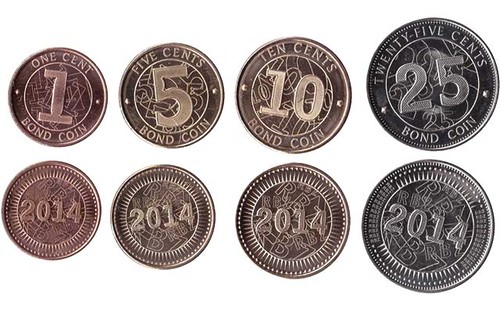
To read the complete Coin World article, see:
Zimbabwe’s 2014 bond coins are entering marketplace
(www.coinworld.com/news/world-coins/2015/04/zimbabwe_s-2014-bond-coins-are-entering-marketplace.all.html)
Jason’s CoinTalk Contest Giveaway #2
Jason Hoffpauir writes:
Below is the link for Jason's Coin Contest #2 Giveaway and the results of the Coin Contest #1. Once again thank you for including our contest in The E-Sylum.
To enter the contest, see: https://www.cointalk.com/threads/jason%E2%80%99s-coin-contest-giveaway-2-1-100-post-coin-contest-giveway.286350/
To read the earlier E-Sylum article, see: COINTALK COIN CONTEST GIVEWAY CHALLENGE (www.coinbooks.org/esylum_v19n45a17.html)
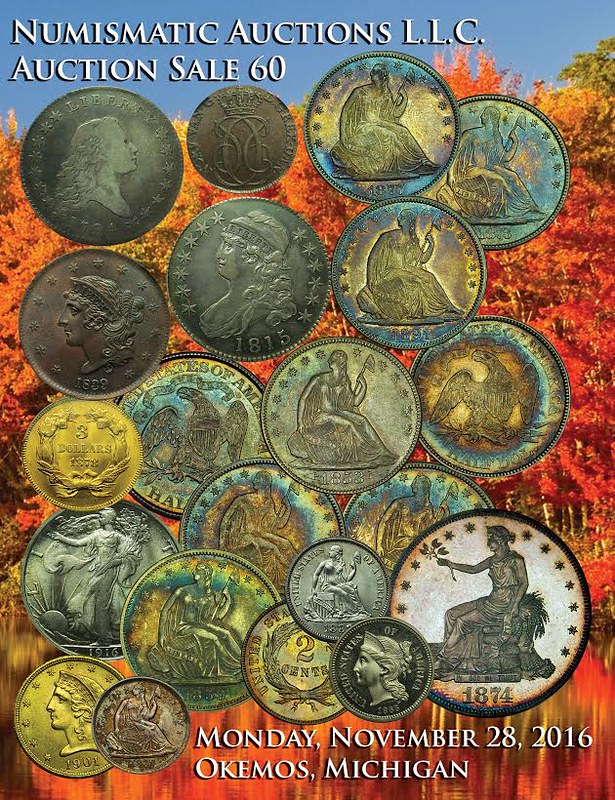
NEWARK SIEGE COIN DECORATES RUBBISH BIN
Collecors of siege coins will enjoy this. David Pickup writes:
I attach some photos of a coin on a rubbish bin taken in Newark, Nottinghamshire. Perhaps there ought to be a catalogue of coins on public utilities!
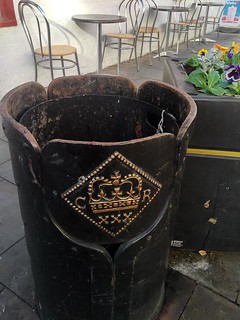
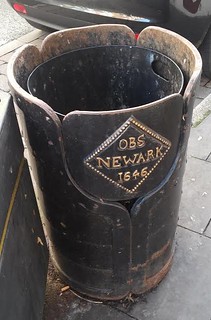
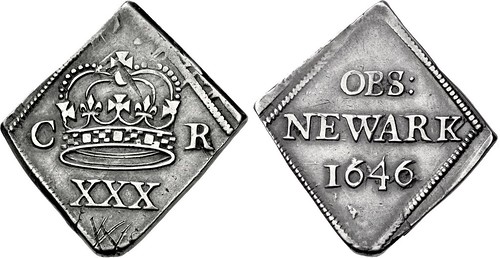
In addition to defeating Royalist forces in the field during the English Civil War Period (1642-1651), Parliamentarian commanders also at several points during this same period besieged those strategically important and heavily fortified Royalist centers. Among these centers, the most important was the city of Newark-on-Trent (commonly shortened to Newark). Located between the rivers Trent and Devon, and at the intersection of the Great North Road and the ancient Fosse Way, the city was a mainstay of the Royalist cause.
In early May 1646, with the New Model Army closing in on Oxford, Charles fled to the Scottish camp outside of Newark, where he surrendered himself to Lieutenant-General David Leslie, acting commander of the Covenanter army. Eager to transport the king to Newcastle-on-Tyne, a place which was more secure and closer to the Scottish border, but unwilling to appear as if he had abandoned his Parliamentarian allies, Leslie urged the king to order the immediate surrender of Newark on reasonable terms. Although Lord Belasyse is said to have wept when he received the order, he had no choice but to obey. Newark surrendered on 6 May 1646 and Belasyse marched out with his much-reduced garrison. On 8 May, the Scots broke camp and marched north, taking Charles I with them in semi-captivity.
To read the complete lot description, see:
STUART, Siege money. Newark. 1645-1646. AR Halfcrown
(www.numisbids.com/n.php?p=lot&sid=288&lot=2613)
W. ELLIOT WOODWARD PHOTO LOCATED
Steve Levine writes:
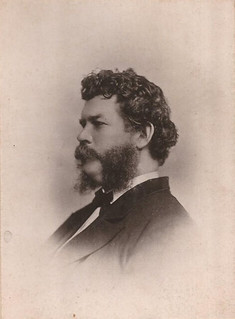 Many years ago, I received three or four inquiries regarding photos of my great-great-grandfather, W. Elliot Woodward. I had none at the time, however following the death of Eugene Elliot Woodward in September, photos of William Elliot Woodward and his son Clarence have been located by Eugene's daughter, Sue Banner, and posted to my Woodward Facebook group.
Many years ago, I received three or four inquiries regarding photos of my great-great-grandfather, W. Elliot Woodward. I had none at the time, however following the death of Eugene Elliot Woodward in September, photos of William Elliot Woodward and his son Clarence have been located by Eugene's daughter, Sue Banner, and posted to my Woodward Facebook group.
I suspect these photos may be of interest to you and others. Note that I also have a newspaper obituary of his son Harlow, with photo, along with a forwarded painting of Harlow as a young child being held, probably by his mother (W. Elliot's wife) Clarissa. Sue Banner has also posted a photo of Clarence, son of W. E. W.
Pete Smith writes:
It is good to know that there are still discoveries to be made that don't involve a computer and Mr. Google.
Joel Orosz writes:
Many thanks for sharing this striking photo of W.E.W. I have always wondered what the "lion of the day," as the American Journal of Numismatics once referred to him, looked like. Now we know!
Bless those descendants who venerate their honorable ancestors!
William Elliot Woodward
He came to Boston in 1848. He managed a pharmacy in Boston. At one time he owned a large amount of real estate in Roxbury. Married Clarissa Eliza Rays in 1848. They had two sons including Harlow Elliot Woodward who inherited much of his collection. Elected to the Boston Common Council in 1873. He was interested in mnemonics, a topic best forgotten. He purchased collections from Jeremiah Colburn, J. O. Emery, John McCoy and Joseph Mickley. He issued fixed price lists 1862 to 1864. He conducted auctions 1 thru 17 in 1860 to 1867. He sold off an extensive library in 1867. He temporarily left the numismatic business to become a real estate developer in Boston. His 18th sale was in 1874. In 1878 he resumed regular sales conducting several each year until 1890. Gengerke lists 112 total sales 1860 to 1890. He was a member of the Boston Numismatic Society and the Washington Lodge of Freemasons. He died at home in Roxbury, Massachusetts. In 2010 he was inducted into the PCGS CoinFacts Coin Dealer Hall of Fame. bio: Adams I; Attinelli; The Asylum X:1 1992; NUM/NIN 2/97 obit: AJN 26 Jan 1892 pages 70-71 (gives DOB as 11/25/1825)
To read the complete article, see:
William Elliot Woodward
(https://nnp.wustl.edu/Library/PersonDetail/2055)
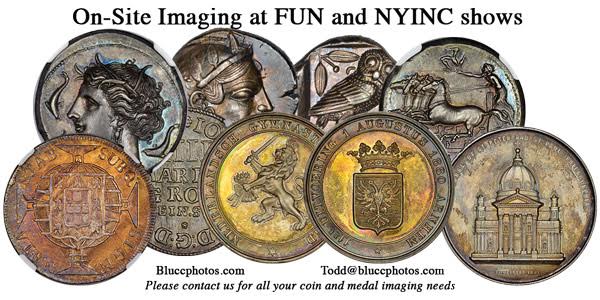
VOCABULARY TERM: PLANCHET

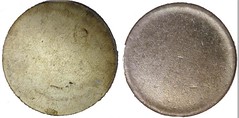
Blank vs. Planchet is demonstrated in these photos. Not all blanks are planchets but all planchets are made from blanks. Center is a half dollar blank (Type I) and right a half dollar planchet after it is upset with a raised rim and perfectly round, ready to be fed into a high-speed coining press (Type II). Clad edges shown on left. Photos courtesy Fred Weinberg.
Planchet. . A round metal disk (or other shape) made from a blank for striking into a coin or medal. While the term BLANK is widely used in the metalworking field, planchet is only used for coins and medals to be struck in coining presses. A planchet is the end product of blanking where metal of the proper composition, weight, and thickness is made into a blank which is prepared by treatment of the edge for use in a coining press..
The blanking process, formerly called cutting and cutting-out (particularly in England), leaves a BURR on the exit side of the blank. The piece must be DEBURRED. This, plus additional preparatory steps, occur by UPSETTING in an UPSETTING MILL (British terms “rimming” and “rimmer”) which thickens the edge, makes the piece perfectly round, in addition to deburring. Since this step WORK HARDENS the blank, it must be ANNEALED (or softened), then RIDDLED (to eliminate imperfect blanks) and METAL CLEANED (to remove all surface contaminants). At this stage the planchet is ready to be fed into the press. All of these steps are required to create perfect blanks for automatic feeding into coining presses (if not they would cause mis-strikes and could jam the press). See BLANK, BLANKED, BLANKING.
A blank planchet is a blank before it is upset (while the two words are similar they are not redundant). Collectors call this stage a type one, and after it is upset, type two (illustrated above). A better terminology for these two stages would be "blank" for type one, and "press ready planchet" for type two. Current usage, however, “press ready” is understood for a planchet.
CLASS 06.2
CHARLES PATTEN SHILLABER (1853-1911)
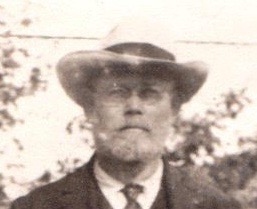 Charles Patten Shillaber (1853-1911), second son of four children of Jonas Green Shillaber (1821-1884), a wealthy trader in the shoe manufacturing industry, and his wife Caroline Matilda Patten (1825-1898) of the Shillaber family of Boston. The Shillaber family traces its roots to New England during the early Colonial period. He attended Massachusetts Institute of Technology from 1872-1873. He traveled to Paris, France in November 1878.
Charles Patten Shillaber (1853-1911), second son of four children of Jonas Green Shillaber (1821-1884), a wealthy trader in the shoe manufacturing industry, and his wife Caroline Matilda Patten (1825-1898) of the Shillaber family of Boston. The Shillaber family traces its roots to New England during the early Colonial period. He attended Massachusetts Institute of Technology from 1872-1873. He traveled to Paris, France in November 1878.
In 1882, he served as the Treasurer of the League of American Wheelman, bicycling club, and the following year the Vice President. He was also a member of the South Framingham Gun Club and won second prize in 1904. He was also an angler and caught tarpon.
He was the director of the National City Bank of Lynn, Massachusetts from 1893 to 1901 when he resigned.
In December 1905 he was elected one of the vice-presidents of the Middlesex South Agricultural Society.
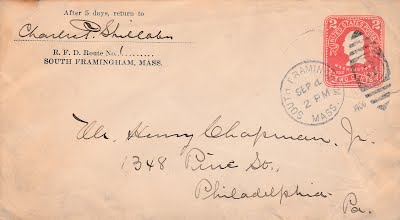
He used to correspond with Henry Chapman for coins and mailed in bids for auctions beginning in 1906. He joined the ANA in August 1908 and was vouched for by Herbert Ellis Morey (1848-1925), the illustrious coin dealer and Howland Wood (1877-1938) of both ANA and ANS fame.
He died of a heart attack on July 11, 1911.
To read the complete article, see:
SHILLABER, CHARLES PATTEN
(www.numismaticmall.com/numismaticmall-com/shillaber-charles-patten)
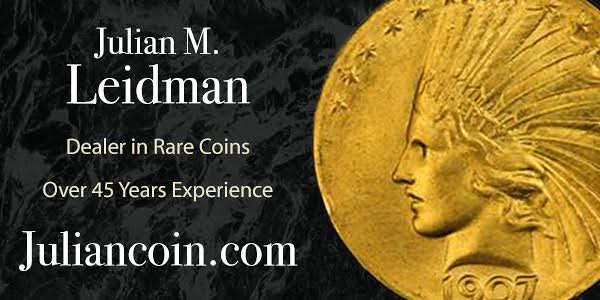
BUILDING THE LILLY COLLECTION, CONTINUED
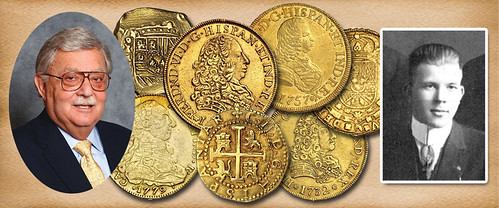
We knew he wanted to finish his double eagle collection, but there was still one piece needed to do it. Our ad offering to buy a 1926-S had received no response, but we continued to mention it to the dealers who traveled overseas, and hoped that they might help us locate this missing link.
We had a visit from Mr. Lilly on his way home in the spring of 1956 and he was pleased with what we had accumulated. As we expected he asked about the 1926-S double eagle. We told him that we had not been offered one in response to our reward ad. We arranged a date to deliver what we had acquired to Indianapolis in the early part of May. Before that, in April of 1956, I went to the Central States Numismatic Convention with my father, Morton, to locate more items for Mr. Lilly. During the first two days of that event we were able to add some foreign and ancient gold, but the missing $20 gold piece was not offered.
On the third day of the show, James Kelly, together with his recent partner, Paul Witlin, a dealer-jeweler from New York, came up to our table. "Is your offer still valid?” asked Jim. My father replied that we still wanted one." Jim reached into his pocket, took out a 2 X 2 envelope, and placed the coin on a pad at our counter. "There it is,” he said. “I want my $500 reward!"
Morton replied, "You got it!" and said, "Now tell me where I can buy it." Jim responded, "From me." Morton wrote out two checks, one for $500 and one for $3,000. This was quite a good deal for Jim Kelly as he received not only the reward money, but also all the profit that came with selling the coin for $3,000 -- a price way above the current market price.
As soon as we could we sent a telegraph to Mr. Lilly, saying the double eagle collection was now complete! We would deliver the missing link with the other items in May and we would give the 1926-S to him at cost, as we felt we had paid a ransom price to get it. My father spoke to Mr. Lilly and received a wonderful "thank you" for completing that collection.
We returned to the bourse floor the following morning. Then the "sky started to fall." One dealer offered us a 1926-S for $2,500, while another had one for $2,000. Then we could get one for $1,500 or even $1,300, without the reward! We took an option on the $1,300 coin, as it was of equal quality as the one we got from Kelly, and were lucky enough to reach Mr. Lilly on the telephone.
We told him the whole story, and that we would buy the $1,300 piece, deliver it to him in May and consider the $3,500 not available. Mr. Lilly said: "Mort, let me tell you that what happened to you was surely not your fault or your company’s. You tried for about a year to finish my double eagle collection. You tried something different than I have ever seen in the hobby business, by tempting someone with a reward to find the coin. You may have been taken advantage of, but I will take the first specimen at the $3,500 you paid for it.” He went on to thank Morton and Stack’s for building his set at a fair market price, and felt that he had benefited from our experience and network of contacts.
Wow, that was a gentleman. In 1956 to give up $2,200 (the difference of the cost of the one we purchased from Kelly and the one we could have gotten for $1,300) represented a sizeable amount of money to lose.
Mr. Lilly was definitely a class act.
So we continued our search, working to help Mr. Lilly build a world-class collection and in May 1956 I made my now familiar delivery trip to Indianapolis.
The main two coins that he still needed were the 1870-S $3 gold (at the time part of the Eliasberg Collection) and the 1822 $5 gold. I felt that since Amon Carter, Sr. who died who had an 1822 $5, that was the most likely one that could be acquired. That collector’s son, Amon Carter, Jr., liked paper money more than the coins, and had indicated to us that sometime in the future that coin might be made available. But he never set a time for it. Mr. Lilly said, "Rome wasn't built in a day, neither will my collection be!”
We discussed various other areas, such as Ancient gold coins and the extensive medieval series. Mr. Lilly asked that I prepare an outline and listing of how he should continue, and that we continue seeking more Spanish American gold coins, along with the few U.S. pieces needed to finish his set. He also asked us to work on expanding his English and French coin collections.
Mr. Lilly remarked that in the past five years he had assembled close to 2,000 different gold coins and that he had enjoyed owning these examples of monetary history of the world.
Mr. Lilly was pleased with what we had amassed and we discussed the various collections and I expressed how honored we were to be his sole dealer. We told him of the dealers we worked with. Often these dealers (as well as collectors) asked us, “Who is your client?” We of course kept it a secret, for Mr. Lilly wanted to keep private what he was doing. Of course we followed his instructions to the letter. We even had a story we used for a few dealers who made special efforts to assist us, telling them that we had several different clients, one who liked doubloons, another who like United States gold, another who collected Ancients, another who liked England and France, etc. It may seem a fantastic story, but it was believed, even though our want lists showed various forms of specialization. We did the same for other clients who desired anonymity. We kept their secrets and in that way kept the confidence of the collectors we dealt with.
Harvey adds:
Many $20.00 gold pieces were found in overseas banks after World War II where they were held instead of paper money. When the U.S. was settling debts after World War I, we paid in bars and coin. So they became the hidden treasures held overseas.
When the Central Banks and banks that started to settle their debts they allowed dealers and traders to go into their vaults and pick out rare dates of U.S. coins. In a trip to Europe Kelly found a hoard of 1926-S double eagles.
It was at the Central States convention that Kelly claimed his reward, and the $3000 we paid for one. He did not like Stack's as we captured a great collection from him, (which he thought he had). He claimed both the Reward and the Purchase price. The next morning Kelly flooded the show floor with 1926-S coins.
Once our bid was out of the market, the prices dropped like a stone and before noon, the dealers on the floor tried to sell theirs to us or others, based on our price, and no one wanted to own one at that figure, We could have bought quite a few at just over $1200 each.
To read the complete articles, see:
Building a World Class Numismatic Gold Coin Collection: The Josiah K. Lilly Collection Part 11
(www.stacksbowers.com/News/Pages/Blogs.aspx?ArticleID=2278)
Building a World Class Numismatic Gold Coin Collection: The Josiah K. Lilly Collection Part 12
(www.stacksbowers.com/News/Pages/Blogs.aspx?ArticleID=2296)
Building a World Class Numismatic Gold Coin Collection: The Josiah K. Lilly Collection Part 13
(www.stacksbowers.com/News/Pages/Blogs.aspx?ArticleID=2311)
To read the earlier E-Sylum articles, see:
BUILDING THE JOSIAH K. LILLY COLLECTION
(www.coinbooks.org/esylum_v19n23a15.html)
BUILDING THE LILLY COLLECTION, CONTINUED
(www.coinbooks.org/esylum_v19n27a13.html)
BUILDING THE LILLY COLLECTION, CONTINUED
(www.coinbooks.org/esylum_v19n31a17.html)
BUILDING THE LILLY COLLECTION, CONTINUED
(www.coinbooks.org/esylum_v19n35a19.html)
BUILDING THE LILLY COLLECTION, CONTINUED
(www.coinbooks.org/esylum_v19n39a19.html)
1933 DOUBLE EAGLE CASE MAY GO TO SUPREME COURT
One coin Josiah Lilly didn't have was the 1933 $20 gold piece, which had been declared by the government as illegal to hold. The only publicly known piece at that time was the Farouk specimen, which had been withdrawn from the sale of the Palace Collection and gone into hiding. But a secret hoard was in the hands of Israel "Izzy" Switt, a Philadelphia dealer with contacts at the U.S. Mint.
Descendants of Switt, the Langbord family, filed a petition with the U.S. Supreme Court this week in what could lead to the ultimate resolution to the battle over their ten 1933 double eagles. Here's an excerpt from a November 11, 2016 Coin World story by Steve Roach. -Editor
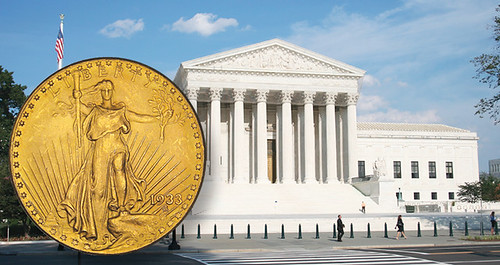
The Langbord family filed a petition with the United States Supreme Court on Nov. 4, asking the nation’s highest court to overturn a District and Appellate court who each held that the family’s 10 1933 Saint-Gaudens double eagles were stolen government property.
The filing repeatedly warns that the issues at hand are bigger than the 10 coins that were allegedly found by Joan Langbord in her family’s safe deposit box in 2003 and directs the Supreme Court to two key questions.
First, the petition asks whether the government can avoid the rules set forth in the Civil Asset Forfeiture Reform Act of 2000 (CAFRA) when it seizes property from private citizens and intends to keep it by asserting that it was stolen government property and declaring that it has no intention of seeking forfeiture. The second question is whether the government can avoid CAFRA’s protections by waiting for years and then filing a declaratory judgment claim that seeks the same relief.
In asking these two questions, the filing states that the court would give clear guidance to the government, property owners and lower courts in determining when CAFRA’s timelines and protections are triggered. Assessing a broader interest beyond a specific pattern is crucial in making a persuasive request to the Supreme Court, who only hears a small fraction of the cases presented to it.
Parties who disagree with a lower court’s decision are allowed to petition the Supreme Court to review a case. The petition for a writ of certiorari was submitted on behalf of Joan Langbord and her sons, Roy and David, by the family’s longtime attorneys Barry Berke and Eric Tirschwell.
At the core of the petition is CAFRA, which Congress passed in 2000 to provide added protections to individuals by shifting the burden of proof to the government to prove when property can be subject to forfeiture.
CAFRA established procedures, deadlines and penalties to ensure that disputes over seized property were fairly and promptly resolved through legal channels. The filing warns that as it was applied in the Langbord case, “the purposes and principles of this groundbreaking law are thus turned upside down, granting the government virtually unfettered powers to delay, harass and burden the rare citizens who attempt to fight back against government overreaching.”
Joan Langbord allegedly found the disputed coins in 2003 when looking through property that had belonged to her father, Israel “Izzy” Switt.
I couldn't tell a writ of certiorari from an eye of newt. This is why the hobby needs a strong subscription publication like Coin World - only a paid staff of professionals can hope to properly cover a complicated years-long story like this. People tend to think of The E-Sylum as a scholarly publication because it looks and feels like one, but the truth of the matter is that internet blogs like this are built on smoke and mirrors. It's just me, one person working part time to throw something together with no staff, fact-checkers or editors to ensure accuracy. I'm lucky because the quality of our readership and contributors is so high - that's the secret sauce. I couldn't begin to write an authoritative article on this topic, even though I've read both books and followed the story for years. I'm a Coin World subscriber, and most of you should be, too. -Editor
To read the complete article, see:
Langbord family petitions U.S. Supreme Court for return of 1933 double eagles
(www.coinworld.com/news/us-coins/2016/11/family-seeks-highest-court-rule-on-coin-ownership.html)
To read the complete article, see:
DID THE LANGBORDS FILE AN APPEAL ABOUT THE 1933 DOUBLE EAGLES?
(https://forums.collectors.com/discussion/971223/did-the-langbords-file-an-appeal-about-the-1933-double-eagles#latest)
To read the Langbord Petition for Writ of Certiorari, see:
PETITION FOR A WRIT OF CERTIORARI
(www.dropbox.com/s/41uwwspfixf1kui/Langbord%20Cert%20Petition.pdf?dl=0)
Harvey writes:
Remember that the one Farouk had was sent to him with a license from the Secretary of the Treasury in 1944 as he was a important ally to the U.S. That is the coin that ws later seized and sold for over $7 Million.
During the 1940's the Secret Service, under the direction of Leland Howard, who in 1961 became Director of Gold and Silver Operations for the Treasury had the Secret Service try to seize any 1933 on the market. One was removed from our Wharton sale in 1947, and people like Eliasberg and James Stack to mention a few surrendered their examples for they were being seized, and did not want the Treasury to try to grab theirs, and also make some sort of ruling that the other Gold coins in their collection were "collectibles" according to the Gold Acts pf 1933 and 1934. They felt that if the coin was made a collectible again, they would buy one once again for their collections.
There was a trial in 1947 and Wharton rather than continue his fight, surrendered his coin to the Secret Service. He was initially represented by Harry J.Stein, a numismatist, who was the lawyer who attempted to force the return of the coin in 1947-8 when the appeal lost again.
So since we could not sell the coin legally, we never sought one, nor did Lilly want one. Had he been alive in 2002 when we sold the only legal one to own today along with Sothebys I am sure we would have had a super bid from him.
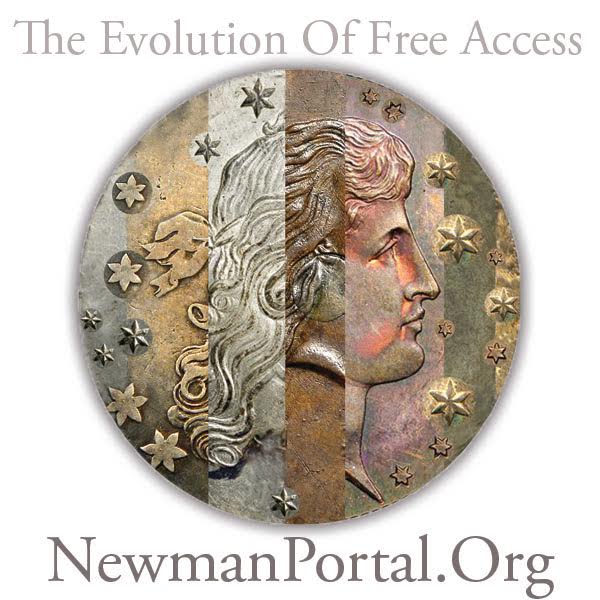
COLONIAL NOTE ADDED TO FORT MOULTRIE EXHIBIT
In the Spring 2016 issue of The C4 Newsletter published by the Colonial Coin Collectors Club, Ray Williams had an article about the 1778 ten shilling note from South Carolina. He also published a shorter piece in the October Numismatist from the American Numismatic Association.
The note that inspired his articles is now on display at a museum in that state. Below is a message Ray posted to the colonial coin Yahoo group on November 11, 2016. -Editor
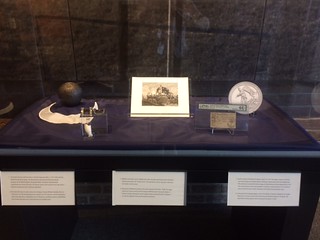 I think you all have read my article about the Battle of Fort
Sullivan (later named Fort Moultrie) being portrayed behind the Palm Tree in the vignette of the 10s SC 1778 bill. Attached are two pictures of an exhibit at Fort Moultrie, which now contains that bill I pictured in the C4N article.
I think you all have read my article about the Battle of Fort
Sullivan (later named Fort Moultrie) being portrayed behind the Palm Tree in the vignette of the 10s SC 1778 bill. Attached are two pictures of an exhibit at Fort Moultrie, which now contains that bill I pictured in the C4N article.
When Diane and I visited Fort Moultrie in September, no one even knew about the bill. I had brought mine with me to show them. I donated the bill to the museum and they were thrilled to have it. I was sent these pictures by Dawn Davis at the museum. I hope some numismatists will wander thru the museum and enjoy the bill.
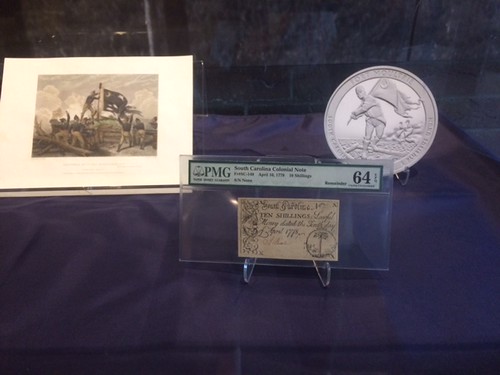
Kudos to Ray for his thoughtful donation. It benefits not just the numismatists who view the exhibit, but all museum visitors and helps promote numismatics (both study and collecting) far beyond our own little clubs.
I'm a little surprised that museum staff didn't remove the note from its modern third-party grading holder. That detracts from the experience a bit. Nevertheless, the note is a great artifact and drives home the point that the Fort is not just a Civil War locale, but one that has been active since the time of the revolution. Here's an image of the note itself. -Editor
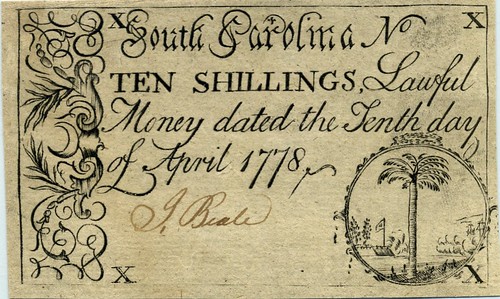
Ray adds:
The note is called a remainder on the slab. As with New Jersey bills, I suspect South Carolina applied just one signature to their bills, and only applied the second signature when the bill was placed into use.
The battle of Fort Sullivan (later called Fort Moultrie) was important in that the Patriot victory prevented the British from capturing Charleston for about another four years.
Diane and I were on vacation in South Carolina in September. After visiting Fort Sumter (very worthwhile), we drove to Fort Moultrie. I had hoped to make the visit and brought my Palmetto Bill with me. When we entered the museum, there was a young park ranger to greet us. I asked if there was a curator on staff that day, to which she asked if I had something to show. She made a call and an associate curator came to the front.
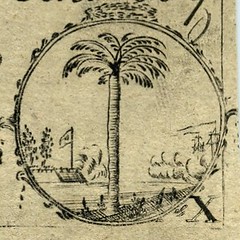 I showed both of them the bill, describing the battle of Fort Sullivan being pictured behind the Palm Tree. The Patriot fort to the left, firing on the British fleet, which was returning fire on the right. I also let them know this was the ONLY Revolutionary battle portrayed on a colonial bill. Their eyes were like saucers!
I showed both of them the bill, describing the battle of Fort Sullivan being pictured behind the Palm Tree. The Patriot fort to the left, firing on the British fleet, which was returning fire on the right. I also let them know this was the ONLY Revolutionary battle portrayed on a colonial bill. Their eyes were like saucers!
The young man escorted Diane and me to an adjacent office building where we were introduced to Dawn Davis, a National Park Service representative. We shared the story with her and she was fascinated. I offered to lend the bill to the museum for an exhibit. Dawn took us back to the museum and showed us the case where it would be displayed. There is paperwork and procedure to follow with museums. In the mean time, I had a change of heart and decided to donate the bill rather than lend it.
I learned about this bill in the ANA's Summer Seminar, where I attended the course on colonial paper money, instructed by John Kraljevich & Erik Goldstein. After Erik showed an example of this bill and talked about the battle it portrayed, I decided I gotta get me one!
I know of one friend attending the release of the Fort Moultrie Quarter next week. Hopefully others will see the bill on display in the museum.
For more information on the exhibits, see:
Fort Moultrie Visitor Center Museum Exhibits
(www.nps.gov/fosu/learn/historyculture/fomovcexhibits.htm)
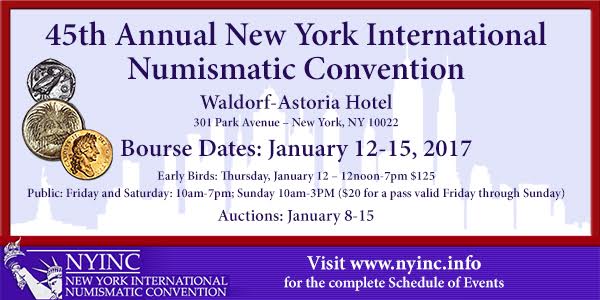
VERY SPECIFIC MUSEUMS
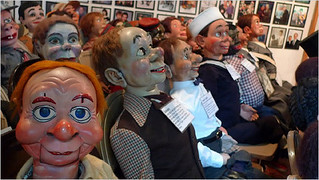 Museums like the Smithsonian or the American Museum of Natural History, visitors can see a whole swath of artifacts relating to diverse pockets of human culture. These museums are not like that. Instead, they tirelessly devote themselves to appreciating one incredibly specific item.
Museums like the Smithsonian or the American Museum of Natural History, visitors can see a whole swath of artifacts relating to diverse pockets of human culture. These museums are not like that. Instead, they tirelessly devote themselves to appreciating one incredibly specific item.
You might wonder, how can a museum sustain an entire collection of bananas? Or kazoos? Or snoring? These museums mostly grew out of one person’s obsession, who then opened their collection to the public. And in delving deep into these oft-overlooked items, the curators of these niche museums do us a great service.
By amassing thousands of the same object, these 66 collections reveal unexpected details about the very particular passions of humans. That, or you’ve just got a whole mess of silly items on your hands.
You've GOT to browse these. Here's a sampling.
- American Banjo Museum
- Spam Museum
- Kansas Barbed Wire Museum
- Toy and Action Figure Collection
- The Button Museum
- The Thimble Museum
- Lunch Box Museum
- Icelandic Phallological Museum (look it up)
- Vacuum Cleaner Museum
And don't forget the Antique Vibrator Museum, or the world's largest collection of ventriloquism dummies. Who knew?
One I'd never heard of but of possible interest to numismatists is the John M. Mossmann Lock Collection, a New York City exhibit of hundreds of antique bank vault locks. -Editor
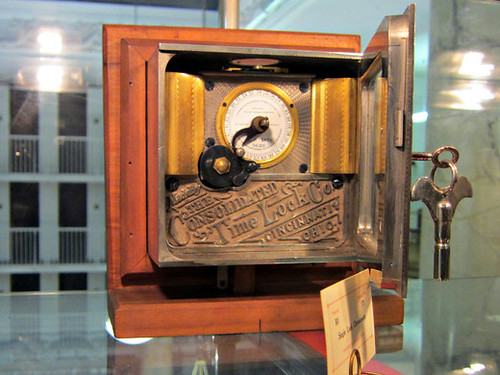
To read the complete article, see:
66 Museums Each Dedicated to One Very Specific Thing
(www.atlasobscura.com/lists/66-museums-each-dedicated-to-one-very-specific-thing)
ARTICLE EXAMINES SATIRICAL HARD TIMES BANKNOTE
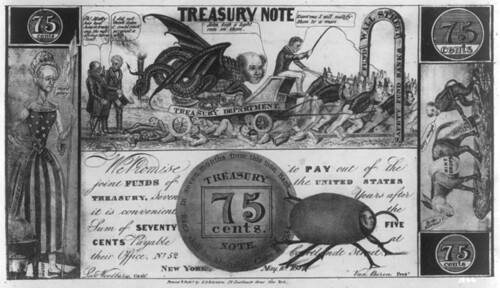
Blur your eyes, and the banknote above looks normal enough. It has the right proportions. It’s covered in intricate line drawings, so as to discourage counterfeiting. It’s got serious-looking slogans and strongly penned numbers. If someone passed it to you across a counter after a long night, you might not look twice.
Focus, though, and you’ll notice a few weird things going on. A panel on the left side shows a bony, balding person dressed in a tattered American Flag. Across the top, a dragon rides a carriage through the streets, crushing pedestrians willy-nilly. The right side sports a donkey defecating into a monkey’s top hat. And along the bottom, a dung beetle with a human face rolls a poop ball emblazoned with the bill’s weird denomination: 75 cents.
In case you hadn’t guessed, this bill is not legal tender. It’s a parody note, “issued” during the Panic of 1837 to lampoon the figures on whom the artists blamed the crisis. Today, it provides a monstrous sort of history lesson, along with a timeless example of bonkers political art.
Look closely at its weird populace, and you’ll see the caricatured faces of towering historical figures. That lady on the left side? “That’s Andrew Jackson in drag,” says Lepler. Jackson is dressed as Lady Liberty, and holding a knife that says “veto,” meant to remind everyone of that time he had vetoed the Second Bank of the United States. The cracked globe he is standing next to represents The Globe, the leading newspaper of his party. “It was kind of the Fox News of its time,” says Lepler.
Jackson also makes a second cameo on the right side, this time as an incontinent donkey. “He’s pooping out gold currency because that’s supposedly what he wants to happen to the money supply,” explains Lepler. His vice president and successor appears too: “Martin Van Buren, his little trained monkey, is collecting the poop in a top hat.” Van Buren was also widely maligned, both for sucking up to Jackson and for continuing his policies once he himself had taken office. (He was also considered overly stylish, which explains the top hat.)
It is also Van Buren’s face on the crazy dragon on the top of the note, hoarding bags of money and riding in a wagon labeled “Treasury Department.” The wagon is being pulled by Loco Focos, who in turn are being whipped by John C. Calhoun, an infamous Southern successionist who supported Jackson on economic issues, if very little else. The whole crowd is running roughshod over people in the street. “A lot of Democratic support came from working class men,” says Lepler. “They’re trampling them.”
And then there’s the dung beetle, sporting the small, determined face of Missouri senator Thomas Hart Benton. “Benton was known as Old Bullion Benton, because he was really in favor of hard currency,” says Lepler. “People called specie ‘Benton’s Mint Drops.’” The Benton bug is pushing a massive lump of dung, labeled with the banknote’s supposed value. Around him, in pompous script, loops a promise “to pay out of the United States Treasury, seven years after it is convenient, the amount of seventy-five cents.”
It’s difficult to consolidate a whole issue into an image, as evidenced by today’s one-panel political cartoons. As monstrous as this one looks, it’s actually pretty subtle, lampooning the country’s sad situation in its form—a useless piece of paper, dressed up as money—as well as its weird, weird content.
To read the complete article, see:
The Best Political Cartoon In History Is This Fake Banknote from the Panic of 1837
(www.atlasobscura.com/articles/the-best-political-cartoon-in-history-is-this-fake-banknote-from-the-panic-of-1837)

1875 ONE FIFTH OF A DOLLAR PATTERN
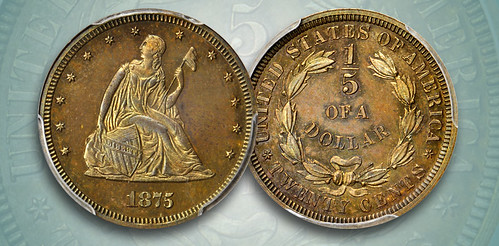
This experimental twenty-cent issue represents a significant milestone in the overall timeline of the denomination as it pertains to the US Mint. The double dime was first proposed as a concept by Thomas Jefferson as an equivalent to one fifth of a Spanish milled dollar, which was a prevalent increment of commerce in 18th century America. In a report to Congress on May 13, 1785, a grand committee of representatives from each of the thirteen colonies rejected Jefferson’s suggestion of a twenty-cent denomination in favor of the quarter dollar, choosing instead to emulate the more common Spanish double reale and English shilling which circulated at a value of twenty five cents.
Proposals for a twenty-cent piece would be reintroduced to congress several times over the next century, failing to gain approval in both 1806 and 1850. It wasn’t until the after Mint Act of February 1873 upset the equilibrium of the nation’s coinage that suggestions of the denomination once again reappeared. This act eliminated the production of silver three-cent pieces, half dimes, and silver dollars, spawning both practical and political concerns that Senator John Percival Jones of Nevada worked aggressively to mediate. Of the more practical concerns, Jones argued, was the shortage of minor coins used to make change throughout the West. The most propagated scenario involved a consumer wishing to purchase an item valued at ten cents, but only having a quarter to pay with. The merchant, also tragically lacking small coins, would only be able to compensate the patron with ten cents in change, shorting them five cents. These exploitive transactions were epidemic throughout the Western US, as per Senator Jones, and a twenty-cent coin was necessary to remedy the situation, he argued.
Less lauded though perhaps more encouraging was the threat to the silver mining industry that the reduction in coin production represented. The U.S. Mint was, at the time, the largest purchaser of silver in the world, and domestic mine owners were very concerned over reduced demand and lower prices. However, despite the seemingly persuasive nature of these concerns, Senator Jones persistently campaigned the “short-change crisis” as his primary argument for the twenty-cent piece, as lobbying too overtly for the mine owners might reveal the fact that he himself was a silver mine owner with a personal interest in the success of the proposed coin. While the legitimacy of the Senator’s claims has never been fully validated, his arguments were convincing enough and the twenty-cent piece was approved as part of the Act of March 3, 1875, nearly a century after Jefferson first suggested the denomination.
Even prior to this official sanctioning, the Mint had begun trialing different designs for the pending double dime in 1874. Mint Director Henry R. Linderman wrote to Superintendent James Pollock on April 20 of said year with his own suggestions for a pattern to be executed, and examples were on hand by the end of the summer. Over the course of the following year, a total of six distinct design combinations would be evaluated, chiefly with the goal of finding ways to differentiate the new coin from the inconveniently similar quarter. A few designs chose to place the denomination 20 CENTS in large characters at the central reverse in order to avoid confusion. In an ever bolder suggestion, one reverse featured the denomination represented by a fraction, reading 1/5 OF A DOLLAR, filling up the upper and central fields. When paired with an obverse similar to the adopted design and struck in copper, this proposed pairing is classified under the Judd-1408 attribution and less than a dozen are thought to remain today.
To read the complete article, see:
Gem 1875 Twenty-Cent Pattern Featured in our November 2016 Collectors Choice Online Auction
(www.stacksbowers.com/News/Pages/Blogs.aspx?ArticleID=2324)
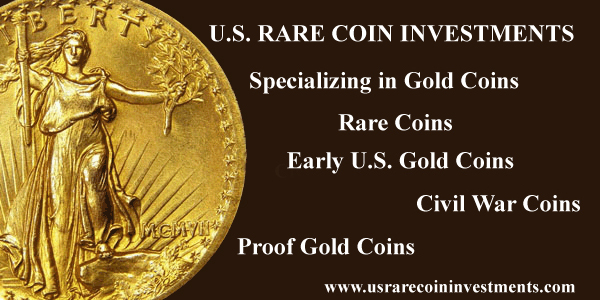
THE CYRUS FIELD MEDAL
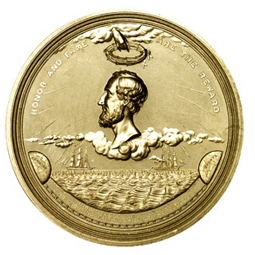
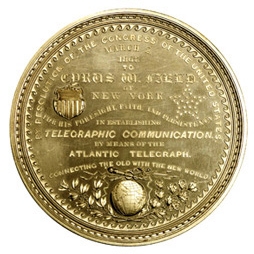
At the present time, in this age of the Internet, we think nothing of contacting a person halfway around the world or visiting a website in some remote country. Yet, it is only in the past few decades that this remarkable change has come about. The revolution in communications, however, began more than 150 years ago…
Perhaps nothing so excited Americans in the 1840s as the telegraph, invented by Samuel Morse. It had spread like wildfire across the United States and Europe, but there was one great gap in this network: the Atlantic Ocean.
As early as 1843 Morse had predicted that the telegraph would eventually cross the ocean and establish instant communication between the Old and New Worlds. Morse’s ideas about an Atlantic telegraph line were not well known, but one person who gave them consideration was Cyrus Field. Mankind had dreamed for centuries of such a link and it was this one man who would bring the dream to reality.
Field crossed the ocean no less than 50 times in accomplishing the crowning achievement of his life. Foreign nations awarded him numerous decorations but the most deserved and highest honors came at home. The U.S. Congress voted him a gold medal in March 1867.
Joseph Goldsborough Bruff, a Treasury staff artist, prepared designs for both sides of the medal by late July 1867 and, after approval by Treasury Secretary Hugh McCulloch and President Andrew Johnson, they were sent to the Philadelphia Mint. Chief engraver James Longacre declined to prepare the dies because of his advanced age so it was turned over to assistant engraver William Barber.
To read the complete article, see:
Field honored for transatlantic cable
(www.numismaticnews.net/article/field-honored-transatlantic-cable)
MILWAUKEE GOLD CARNEGIE HERO MEDAL APPRAISED
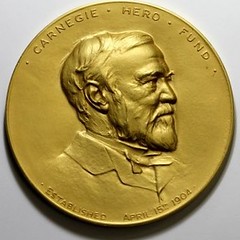
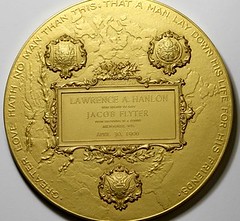
A gold heroism medal awarded to a Milwaukee firefighter 110 years ago has been determined to be worth over $100,000.
The solid gold 22-karat Carnegie medal is one of three awarded to firefighters who took part in a 1906 maritime/tunneling rescue under the Milwaukee River. The firefighters awarded the rescue were Assistant Chief Lawrence A. Hanlon, Capt. Peter Lancaster and fire boat Capt. Harris G. Giddings.
The medal in question was Hanlon’s, and his medal has been in the hands of the Milwaukee Fire Historical Society for decades. Wanting to know the authenticity and makeup of the medal, retired firefighter and a society board member Allan Zehm brought the medal to an appraisal fair in Brookfield.
“We’re not going to sell it, but we had to get some idea what this thing is worth,” he said. “We’re talking about maybe having a replica made and keeping the original in a safety deposit box.”
The medals themselves originate from the Carnegie Hero Fund, which was established by steel industry magnate Andrew Carnegie in 1904 to recognize acts of courage by Americans and Canadians. The medals themselves were discontinued in 1923 and a mere 19 were awarded.
Eric Zahren, executive director of the Carnegie Hero Fund Commission in Pittsburgh, said he was impressed that the medal has surfaced in such good condition after all this time. “The gold medals are extremely rare,” he said. “It’s not often that they pop up anywhere.”
A periodical from the time said that the incident involved a tunnel collapse 70 feet below the surface of the Milwaukee River. As the tunnel filled with water and sand, the fire crew reached Jacob Flejter (erroneously spelled on the medal as Flyter). When Flejter was offered whiskey, he politely declined, telling rescue workers that he promised his mother that he’d lay off the booze.
Rescuer Hanlon was originally ordered not to go in and rescue Flejter by the Mayor. Disobeying orders, Hanlon is said to have told the mayor, “Mr. Mayor, if you were down there, you’d probably like to have somebody try to get you out.”
To read the complete articles, see:
Stingl: Firefighter hero medal stuns appraiser
(www.jsonline.com/story/news/columnists/jim-stingl/2016/10/18/stingl-firefighter-hero-medal-stuns-appraiser/92356210/)
Bravery medal given to three firefighters in 1906 stuns appraiser
(www.firefightingnews.com/bravery-medal-given-three-firefighters-1906-stuns-appraiser/)
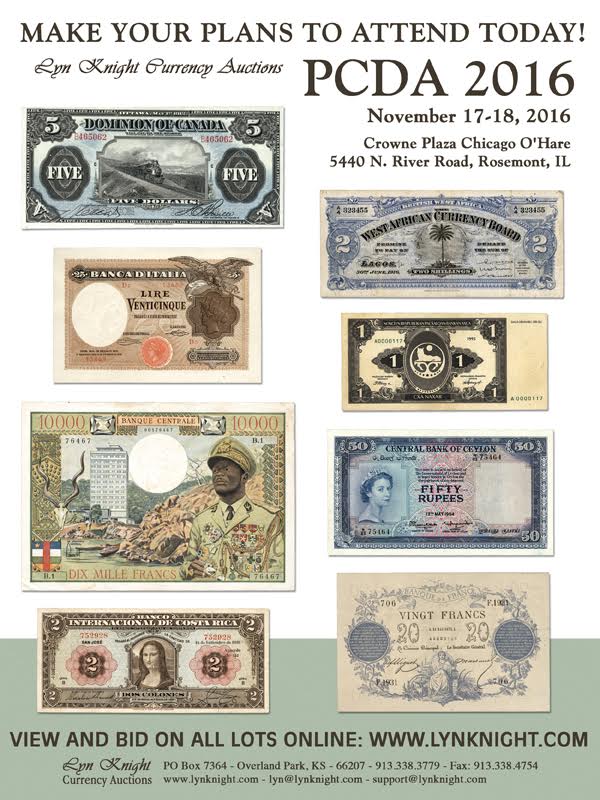
TUSKEGEE AIRMEN RECEIVE CONGRESSIONAL MEDALS
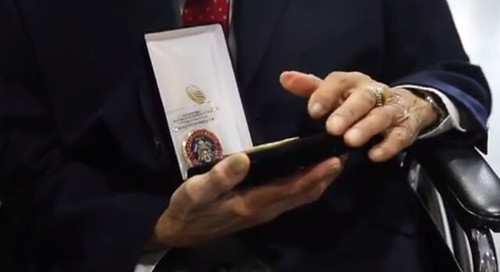
Wallace C. Higgins isn’t a man who sheds many tears.
But on Veterans Day, as Higgins held his Congressional Gold Medal during a ceremony in Geneseo, Livingston County honoring the Tuskegee Airman, things were different.
“I can’t say enough,” said Higgins, 91, who left behind his education in the Kendall Central Schools in Orleans County in 1943 to join the U.S. Army. After aptitude testing and basic training, he was selected to be part of the Tuskegee Airman experiment in Alabama, and was trained in pre-flight at the Tuskegee Institute. “I don’t cry easily, but I do today.”
Now a retired Alfred University professor, he recalled one of his first early flights in Alabama.
“I flew over a circle of cows and they just looked up at me,” he said, laughing at the memory. “So I kept flying round and round over them, just watching them.”
Higgins was one of five Tuskegee Airmen honored on Friday at the National Warplane Museum in Geneseo.
 In 2007, the honor of the Congressional Gold Medal was secured for all men and women involved in the Tuskegee Experience, the Army Air Corps program to train African-Americans to fly and maintain combat aircraft during World War II. “Tuskegee Airmen” refers to “all persons involved in the program and includes pilots, navigators, bombardiers, maintenance and support staff, instructors and all the personnel who kept the planes in the air,” according to TuskegeeAirmen.org.
In 2007, the honor of the Congressional Gold Medal was secured for all men and women involved in the Tuskegee Experience, the Army Air Corps program to train African-Americans to fly and maintain combat aircraft during World War II. “Tuskegee Airmen” refers to “all persons involved in the program and includes pilots, navigators, bombardiers, maintenance and support staff, instructors and all the personnel who kept the planes in the air,” according to TuskegeeAirmen.org.
Brooklyn native Herbert Thorpe of Rome, Oneida County, 93, joined the Army Reserves in 1942. He was commissioned a second lieutenant and earned his B-25 pilot’s wings in October 1942. He, like Higgins and many other Tuskegee Airmen, was unable to attend that original 2007 ceremony.
“Not being able to be at that original presentation; this is very special to me,” said Thorpe, who also received a Gold Medal for his brother Richard Thorpe, who was killed during an orientation flight in Italy in 1945.
“I have to thank so many people for this special occasion,” he said.
More than 200 people gathered for the event amid the museum’s historic warplanes and military memorabilia.
Rep. Christopher Collins, R-Clarence, Erie County, presented the medals.
To read the complete article, see:
5 Tuskegee Airmen honored in Geneseo
(www.democratandchronicle.com/story/news/2016/11/11/tuskegee-airmen-honored-geneseo-today/93637848/)
WHO WILL BE THE NEXT U.S. MINT DIRECTOR?
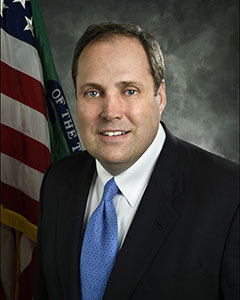 There might be a new Mint director in office in 2017. Technically it has been vacant since Edmund C. Moy left office in 2011.
There might be a new Mint director in office in 2017. Technically it has been vacant since Edmund C. Moy left office in 2011.
The Mint director’s position is one of roughly 4,000 in the executive branch to be appointed by President Donald Trump and confirmed by the U.S. Senate.
Since Moy left office, two names have been sent to the Senate to succeed Moy, but neither one was confirmed.
The most recent name sent up Capitol Hill is that of Rhett Jeppson, who is principal deputy director of the United States Mint. The Senate got it last year.
Jeppson is performing the duties of the director without actually having the title.
Perhaps in the lame duck session of Congress held before 2016 ends, he will get the title as well as the responsibility.
Perhaps not.
The reason I mention the possibility is rooted in history.
The precedent Dave cites is Treasury Secretary Joseph Barr, confirmed at the end of LBJ's term. He took office December 21, 1968 but left with the incoming administration of Richard Nixon on January 20, 1969. Although he only served for about a month his signature appeared on the Series 1963B $1 Federal Reserve Note. Many people, my own family members included, hoarded these notes, thinking that they must be rare and valuable. Not so, of course. Millions were printed and remain common today, helped along by all those hoarders.
He goes on to thank Jeppson for his service to date. -Editor
For Jeppson, there is no possibility of a bank note. However, he will leave his mark on the Mint in another way.
His Oct. 13 meeting in Philadelphia, where the best and brightest in the numismatic and related fields gathered, is a serious beginning for mapping our collective future.
What is to be done to an institution whose collector base has fallen in half? What is to be done to bring in new blood?
The answer to these questions when they come will likely be traced back to the Oct. 13 initiative.
For that, Jeppson should be well pleased.
Many changes are coming at us in 2017 and in future years. This will happen no matter who is chosen to lead the United States Mint.
The ultimate question is whether these changes will be forced on us by events, or whether there will be some thoughtful input from the nation’s coin collectors.
For giving us a voice in the process, let’s say thank you to Jeppson.
Agreed. Here's hoping there will be further such discussion sessions, regardless of who ends up leading the Mint. -Editor
To read the complete article, see:
New Mint director after six years?
(www.numismaticnews.net/article/new-mint-director-six-years)
To read the complete article, see:
Memo to the U.S. Mint 2016
(http://news.coinupdate.com/memo-to-the-u-s-mint-2016/)
THE BOOK BAZARRE
2017 LIONS CLUBS DOLLAR FIRST STRIKE CEREMONY
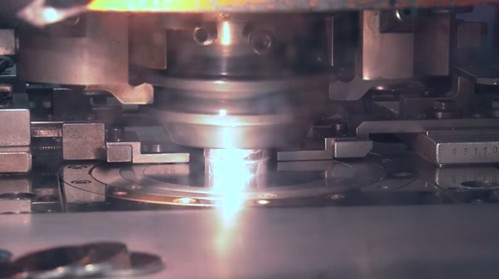
The first strike
Today, November 9, 2016, at its main production facility in Philadelphia, the United States Mint held a special ceremony for the first strike of the 2017 Lions Clubs International Centennial commemorative silver dollar coin.
And CoinWeek was on hand to film the event in high-definition.
According to the Mint's Principal Deputy Director Rhett Jeppson, “Service is a core value of the Mint, and the Lions Clubs is one of the best examples of service not only here in the United States, but across the world.”
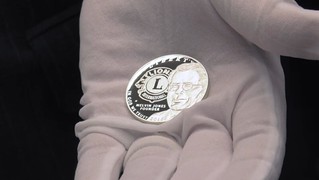 He was joined at the ceremony by James Franklin Moore, III, chairperson of the Lions Clubs International Centennial Committee. It was Moore who struck the first Proof silver coin of the commemorative's run during the ceremony. “Lions Clubs International is honored to be among a relatively few organizations to be included in the United States Mint commemorative coin program," he said. "This is a wonderful way to mark our 100 years of global humanitarian service.”
He was joined at the ceremony by James Franklin Moore, III, chairperson of the Lions Clubs International Centennial Committee. It was Moore who struck the first Proof silver coin of the commemorative's run during the ceremony. “Lions Clubs International is honored to be among a relatively few organizations to be included in the United States Mint commemorative coin program," he said. "This is a wonderful way to mark our 100 years of global humanitarian service.”
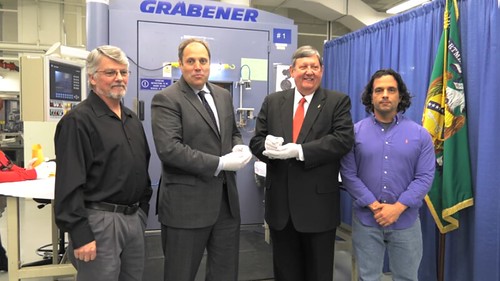
The obverse features Lions Clubs founder Melvin Jones and the intriguingly mythological Lions Clubs International logo. Inscriptions include LIBERTY, the national motto IN GOD WE TRUST, MELVIN JONES, FOUNDER, and 2017. United States Mint Artistic Infusion Program (AIP) designer Joel Iskowitz created the artwork on the front and United States Mint Sculptor-Engraver Joseph Menna engraved it.
The reverse shows a male and female lion pair along with their cub - all superimposed over a globe. Inscriptions include UNITED STATES OF AMERICA, $1, E PLURIBUS UNUM, and CELEBRATING 100 YEARS OF SERVICE. AIP designer Patricia Lucas-Morris and Sculptor-Engraver Don Everhart are responsible for this side.
To read the complete article (and watch the video), see:
U.S. Mint Holds Strike Ceremony for Lions Clubs Commemorative Silver Coin – 4K Video
(www.coinweek.com/us-mint-news/u-s-mint-holds-strike-ceremony-lions-clubs-commemorative-silver-coin/)
JEFF REICHENBERGER ON U.S. MINT PACKAGING
Jeff Reichenberger writes:
I thought of this as an aside to Dick Johnson's comments about U.S. Mint packaging in the October 23 issue.
I wrote this back when I was doing the humor column for Coin World. The premise was the consideration of packaging overkill. They used a stripped down, non-flowing version better suited for the column format. This is the longer, rambling version never published.
This is the story of a package received from the United States Mint.
THE SHREDDED BOX
At 6 p.m. I walked through the door, when my eyes were drawn to a sight on the floor…
There lay a box all shredded and broken, that once cradled a coin before it was open…
Packing foam peanuts all clingy with static, were spread from the cellar floor to the attic…
The treasure within had an outermost wrap, a cellophane bag now ripped into scrap…
Next I discovered a torn paper sheath, that slid onto a white glossy box underneath…
The decorative box of shimmering white, was flat as a pancake, crushed and contrite…
I then found a box of velvety blue, the hinge had been sprung and broken in two…
Out fell a cushion, a silken sham, all smeared with a substance like strawberry jam…
The following scene was entirely drastic, a shattered and splintered capsule of plastic…
The hard plastic capsule where the coin was encased, lay there in pieces all over the place…
It once sat in the cushion now covered in goo, that fell out of the box of velvety blue…
The brand new box of velvety blue, with a busted up hinge that was cracked in two…
From the proud little box of glossy white, that with heinous dispatch had lost the fight…
They all fit so cozily tucked underneath, the now crumpled and torn apart paper sheath…
Sealed up in the bag, the outermost wrap, the cellophane bag now nothing but scrap…
Once protected by peanuts, clingy with static, dispersed from the cellar floor to the attic…
And all packed in the box, shredded and broken, that cradled the coin before it was open…
It was only a matter of simple deduction, that led to the culprit of all this destruction…
The redhead it was, my offspring thug, she sat there among the debris on the rug…
I caught her before she could run to her mother, jellyroll in one hand, coin in the other…
The coin was sticky with red jelly prints, a large silver proof from the United States Mint…
It was ruined by a numismatist’s measure, but to her it was an immeasurable treasure…
We smiled and she gave me a jellyroll kiss, and ran off with the coin in her toddler bliss…
And stuck to her bottom like divine serendipity, the parchment certificate of authenticity…
With the packaging the certificate did come, official document now stuck to her bum…
Along with the coin, sticky with prints, a proof that came from the United States Mint…
Which was once airtight, safe, and fantastic, in the now obliterated capsule of plastic…
All nestled inside the cushioned sham, now covered with remnants of strawberry jam…
The silken cushion smeared with goo, came out of the box of velvet blue…
A lovely box when it was new, now the hinge was snapped and broken in two…
From the glossy box, once sturdy and tight, now flat as a pancake in decorative white…
It was all tucked carefully just underneath, what once was a paper protective sheath…
Encased in the bag, cellophane wrapped, the outermost cover severed and scrapped…
The Styrofoam peanuts, clingy with static, spread out from the cellar floor to the attic…
All out of the box, now shredded and broken, that cradled the coin before it was open…
Seven layers of packaging couldn’t withstand, the exuberant genius of her tiny hands…
Packing peanuts still stuck to my socks, along with cardboard and tape from the box…
Slack-jawed and weak from all this emotion, I needed a drink from a powerful potion…
As I marveled at the whole strange affair, I slumped down in a heap in my favorite chair…
Closing my eyes I pictured her smile, and that made the whole crazy evening worthwhile…
She loved the coin and thought I was great, off went my shoes and I was snoring by eight…
To read the earlier E-Sylum article, see:
DICK JOHNSON ON U.S. MINT PACKAGING
(www.coinbooks.org/esylum_v19n43a27.html)
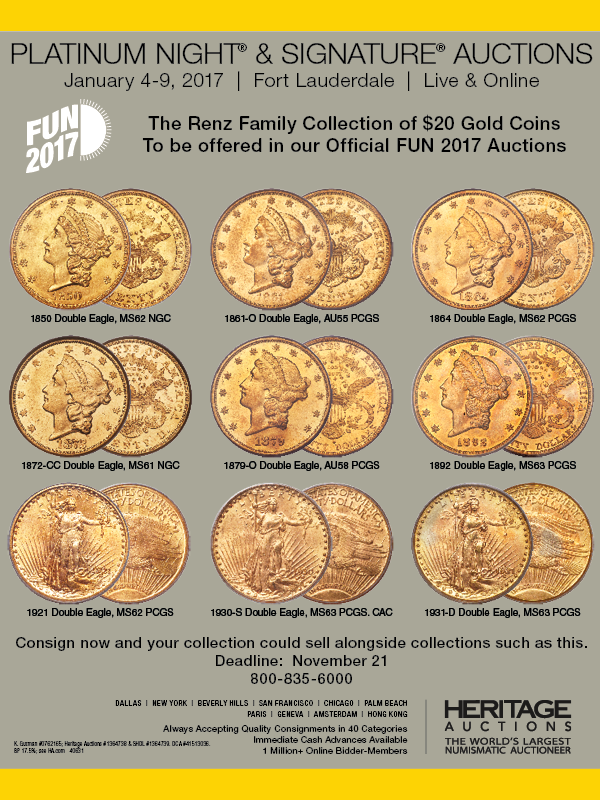
STUDY EXAMINES BRITISH RARE COIN FINDS SINCE 1700
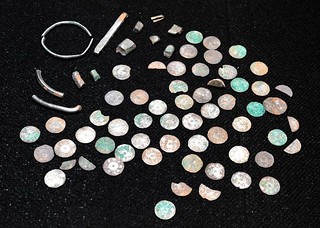 WHEN archaeologists or metal detectorists discover important groups of coins there is an established procedure to evaluate and record them.
WHEN archaeologists or metal detectorists discover important groups of coins there is an established procedure to evaluate and record them.
A good example is the Furness Hoard of Viking era silver coins which is on show at the Dock Museum, Barrow, after being reported through the Portable Antiquities Scheme.
This has not always been the case and many hoards in Victorian times, or earlier, were broken up for sale or melted for the gold or silver they contained. Brief records of many of these forgotten finds are starting to emerge from research using digitised national and regional newspapers.
How the papers gave up their secrets was described by Dr Stephen Briggs in a talk at the Shrewsbury conference of the British Association of Numismatic Societies.
He said the online British Newspaper Archive from 1700 to the present day had more than 15m pages covering 650 publications.
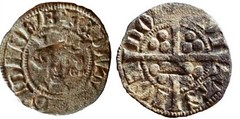 Dr Briggs said: “I’m always looking for nuggets.”
Dr Briggs said: “I’m always looking for nuggets.”
A study of newspaper reports has found mention of 1,500 otherwise unrecorded post-Roman hoards in Britain and Ireland.
These include 30 new finds of Viking coins and 140 from the period of the English Civil War in the 17th century.
In the last three years he has found records of 25 previously unknown coin finds in Cumbria and 67 in Lancashire.
You can find out more about the work of the Portable Antiquites Scheme in reporting and recording finds can be found at https://finds.org.uk/ .
To read the complete article, see:
Rare coin finds have always hit the headlines
(www.nwemail.co.uk/Rare-coin-finds-have-always-hit-the-headlines-53a879d6-1724-4cca-b9e3-2a59165c0b14-ds)
ROMAN COIN HOARD UNEARTHED IN TOMARES, SPAIN
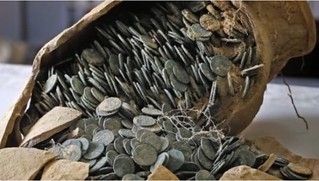 Construction workers laying pipes in a park in southern Spain have unearthed a 600kg trove of Roman coins.
Construction workers laying pipes in a park in southern Spain have unearthed a 600kg trove of Roman coins.
The bronze coins dating from the late 4th Century were found inside 19 Roman amphoras, a type of jar.
They bear images of the emperors Constantine and Maximian and it is thought they may have been used to pay soldiers or civil servants.
The Director of the Seville Archaeological Museum Ana Navarro said the discovery had incalculable value.
"It is a unique collection and there are very few similar cases," she said.
"I could not give you an economic value, because the value they really have is historical and you can't calculate that."
Work on the pipes, in the town of Tomares, has been suspended while an archaeological survey is carried out.
The Romans began to conquer Spain in 218 BC, ruling until the 5th Century.
To read the complete article, see:
Strange Discovery! Unearthed Silver And Bronze-Coated Roman Coins Discovered In Spain
(www.travelerstoday.com/articles/25906/20161108/silver-bronze-coated-roman-coins-discovered-spain.htm)

COIN PLACED UNDER MERCHANT NAVY MONUMENT
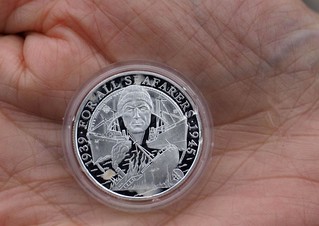 A SILVER coin with special significance has been placed under a new memorial in Weymouth dedicated to Merchant Navy sailors who lost their lives at sea.
A SILVER coin with special significance has been placed under a new memorial in Weymouth dedicated to Merchant Navy sailors who lost their lives at sea.
The memorial on The Esplanade opposite the Pier Bandstand is all ready for its grand unveiling by the Weymouth, Portland and District branch of the Merchant Navy Association on Wednesday (Nov 9) at 11am.
Before the memorial was hoisted into position on its plinth a silver coin that had been minted from the bullion cargo of a sunken World War Two merchant ships was placed underneath it.
The memorial has been carved on Portland, using Portland Stone, and the bronze fittings have been moulded in Bridport, with the railings made in Weymouth.
Captain Paul Compton, of the Merchant Navy Association has previously spoken of how the memorial will be a welcome addition to the town and thanked all those who supported the fundraising effort to enable it to become a reality.
He said: “Weymouth and Portland has a very long maritime history and it is only fitting that we honour the brave men and women who lost their lives at sea while serving their country and their communities.
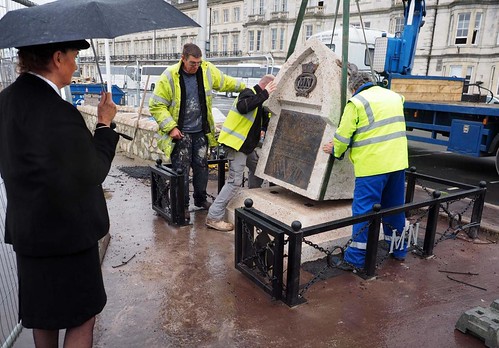
To read the complete article, see:
Special coin placed under memorial to sailors lost at sea
(www.dorsetecho.co.uk/news/14847213.Special_coin_
placed_under_memorial_to_sailors_lost_at_sea/#)
THE SCHOOL OF ENGRAVING
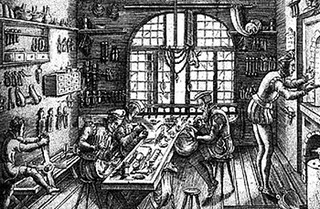 On July 24, 1804, with the creation of the Department of Engraving and Construction of Instruments and Machines for the currency, the School of Engraving was created with Pedro González de Sepúlveda general engraver and his son Mariano as second. As aides were engraved medal, Jose Ignacio de Macazaga and the disciples Isidro Merino, José Muñoz, Rafael Plañiol, Remigio Vega and José María Amat.
On July 24, 1804, with the creation of the Department of Engraving and Construction of Instruments and Machines for the currency, the School of Engraving was created with Pedro González de Sepúlveda general engraver and his son Mariano as second. As aides were engraved medal, Jose Ignacio de Macazaga and the disciples Isidro Merino, José Muñoz, Rafael Plañiol, Remigio Vega and José María Amat.
The Academy of San Fernando had an important participation through the establishment in 1831 of the medal engraving classes, which were not convened since its forced interruption in 1808.
As director of studies Sagau was Felix, former general recorder and among students who were formed there were Luis Marchionni, Eduardo Fernandez and Alberto Estruch Pescador.
1º- Students are presented at school must be precisely young people who do not exceed 24 years, nor have less than twelve, with reports of good behavior and which are with some principles of drawing and model, examining the overall Recorder before being proposed as such.
2º- All students attend school daily for a year, without pay and sort of supernumerary for that at this time the general recorder talent and ensure application, and that they in turn aware of the obligations they have to play, the difficulty of the profession and his long career, determined with full knowledge if they accommodate or not to continue it, then starting the second year of the entry to the enjoyment of salaries shall be subject to serve the respective destinations under this instruction and disposal.
Students 3º- first class will be the main object apply to the engraving of medals, stamps, signatures and more objects of the first order needed.
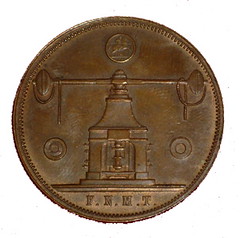 They should learn geometry, delineating architecture and perspective to provide them with the knowledge of machines, symmetry, anatomy, drawing and model, because without this knowledge can not form a good recorder medals. They were also instructed in lime operations, lathe and forging as that of this class have the general recorder out, and therefore teach others of his time.
They should learn geometry, delineating architecture and perspective to provide them with the knowledge of machines, symmetry, anatomy, drawing and model, because without this knowledge can not form a good recorder medals. They were also instructed in lime operations, lathe and forging as that of this class have the general recorder out, and therefore teach others of his time.
To read the complete article, see:
Education for students of the School of Engraving
(www.numismaticodigital.com/noticia/9996/numismatica-de-isabel-ii/ensenanza-para-los-alumnos-de-la-escuela-de-grabado.html)
THE BOOK BAZARRE
MEDALS IN THE MORTON & EDEN DECEMBER 2016 SALE
1789 East Florida Proclamation Medal
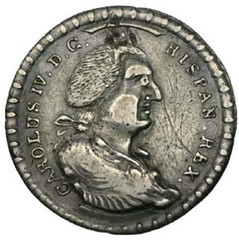
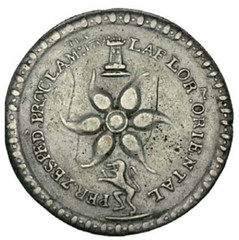
Lot 786
Colonial America, East Florida, Proclamation Medal or 4-Reales, 1789, in silver, commemorating the Proclamation of
Charles IV of Spain as King by the Governor of East Florida Vicente Manuel de Zespedes, armoured and draped bust of Charles
IV right, CAROLUS IV. D. G. HISPAN. REX., rev., a six-petalled jasmine flower at centre, small castle above and lion below, LA
FLORA: ORIENTAL PER. ZESPEDS PROCLAM:TUS 1789, edge obliquely grained, 32.7mm, 12.04g (Breen 1079; Betts 10;
Herrera 133; Medina 148; Grove C.58), lightly toned, a few scratches in fields both sides, small digs above head of portrait and
some casting flaws, about very fine and extremely rare, this example not recorded and not previously offered at auction
£10,000-15,000
The early Colonies of East and West Florida were originally ceded to Britain from Spain under the terms of the 1763 Treaty of Paris which ended the Seven Years’ War. Subsequently they were returned to Spain under the terms of the Treaty of Paris in 1783, which ended the American War of Independence. Soon afterwards Vicente Manuel Zespedes was installed as Governor of the newly returned colony; based at St Augustine, he previously held the position as Governor of nearby Santiago de Cuba in the preceding year. He attempted to increase the population and development of East Florida by luring former Spanish residents to return with the promise of land grants and 10-year tax exemptions, whilst also attempting to retain its British settlers, many of whom were by that time leaving for plantations in the islands of the British Caribbean.
In anticipation of the planned proclamation of the new King Charles IV, commemorative medals (sometimes considered 4-real coins, which they resembled in terms of weight and size) were ordered in advance by Zespedes himself, probably being struck at his own personal expense, to be distributed during the celebrations due to take place on 2-4 December 1789. Three days of festivities followed, with processions, dancing, singing and military parades. It is here that Zespedes, leading the parade, is recorded as having cast handfuls of the newly made ‘silver money’ into the grateful crowd (with no mention of bronze), as recorded in an original letter dated December 9 1789 from Domingo Rodriguez de Leon, a notary based in St Augustine, to a correspondent in Spain regarding the details of the celebrations.
Where, how many, and precisely how these pieces were made, however, remain elusive historical details. Studies concerning this medal have been made by several numismatists, but in particular by John W. Adams and also by Michael Hodder (as shown in the John Ford Jr Collection, Part XIII catalogue), and arguments have been made for the existence of 4 distinct types: struck silver, cast silver, after-cast silver re-issues, and after-cast bronze re-issues. Current theories regarding the place of manufacture vary, but some suggest Mexico City (where an official mint already existed) for the highest quality ‘struck’ examples, and then Havana, Santiago de Cuba or perhaps another local mint in Florida for the remainder, but no concrete documentary evidence exists to date. Given Zespedes’ links to Havana and Santiago and the relatively modest quality of the medals, a Cuban mint (probably at Havana) would seem most logical, as is also suggested by Hodder. Many of the “coins” were perhaps melted down later and consequently very few survive.
Three ‘commemorative medals’ were reportedly sent by Zespedes to the king and a further three to the colonial secretary after the celebrations, and arguably these six medals could account for the supposedly ‘struck’ examples, with all others being cast as intended for general distribution. Nevertheless, it is worth pointing out that even the finest known ‘struck’ example, lot 660 in the John Ford Jr Collection (weighing 13.77g), shows clear casting flaws to the neck of the king’s portrait and in the medal’s fields – much the same as shown in the example offered here. The idea that the finest examples were struck on cast planchets whereas others were more simply cast has been suggested to explain the evident difference in quality. Perhaps the overall finish and craftsmanship used for the king’s & colonial secretary’s examples was of a higher standard - as one might expect and is known in other series. Such examples would have been unlikely to have entered circulation and would therefore have avoided wear. This argument would reduce the need for complex discussions regarding different issues being minted in different locations when the production appears to have been very much more a local one, which would have been under some considerable time pressure between the arrival of the news of Charles III’s death in Florida (March 1789) and the planned proclamation of Charles IV (December 1789). A further argument has been made regarding an apparent difference in legend for struck (TUS) and cast (TUR) examples in silver, but this does not seem to stand up to scrutiny, as each silver example illustrated in recent times appears to read TUS regardless.
In Stack’s Bowers Auction, 26-31 March 2015 (lot 6002, the John W. Adams example weighing 11.61g), 5 silver examples were recorded. Thus the present piece appears to be the sixth known. A further three examples are known in bronze, giving a total of only nine presently known in any metal.
In 1821, under the Adams-Onis Treaty, both Floridas were finally ceded to the United States who amalgamated the two to form the Territory of Florida the following year.
John Paul Jones - The Capture of the British Frigate H.M.S. Serapis
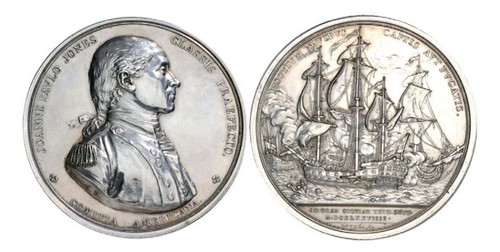
Lot 787
U.S.A., John Paul Jones (1747-1792), The Capture of the British Frigate H.M.S. Serapis by the U.S.S.
Bonhomme Richard off Flamborough Head, 23 September 1779, in silver, Paris Mint, made for the ‘Comitia Americana’
series of medals by Augustin Dupré; bust of John Paul Jones right [after Houdon] in naval uniform, signed DUPRÉ. F. on truncation,
JOANNI PAVLO JONES CLASSIS PRAEFECTO, COMITIA AMERICANA; rev., the naval action in progress showing the
crew of U.S.S. Bonhomme Richard boarding H.M.S. Serapis behind, HOSTIVM NAVIBVS CAPTIS AVT FVGATIS, AD ORAM
SCOTIAE XXIII SEPT M DCCLXXVIIII, 56.25mm (Betts 568; Adams & Bentley, Ch. 8; B.H.M. 222, R2; MH 580; CP 105/22;
Ford XIV 203.), with evidence of die flaws in extremely early stage indicating an original or very early striking, lightly polished
in the past so with hairlines and a few tiny marks, extremely fine and very rare £6,000-8,000
On 23 September 1779 the U.S.S. Bonhomme Richard, under the command of Captain John Paul Jones, led a combined Franco-American fleet of 5 ships against a large Baltic merchant fleet being escorted by the British ships H.M.S. Serapis and the smaller Countess of Scarborough. The fighting took place off the Yorkshire coast near Flamborough Head and the coastal town of Bridlington, when the experienced French Captain Landais of the Alliance engaged and drew away the Countess of Scarborough, leaving Serapis to battle against the 4 remaining American and French ships.
Initially the Serapis inflicted considerable damage to the hull and rigging of the Bonhomme Richard and the American flag fell, prompting Captain Richard Pearson of the Serapis to ask Jones if he had intentionally struck his colour in surrender. Jones defiantly replied: “I have not yet begun to fight!” and after a further three hours of bitter exchange it was indeed the Serapis and Countess of Scarborough which were forced to surrender. The Americans boarded and transferred across to the Serapis following a close, hard-fought victory, with the critically-damaged Bonhomme Richard sinking on the following day.
The victory made John Paul Jones a national hero and this piece from the Comitia Americana series holds the distinction of being the only naval medal authorized by the Continental Congress.
For more information, or to bid, see:
http://www.mortonandeden.com/

PDCA 2016 CURRENCY SALE HIGHLIGHTS
Lot 55: British West Africa 2a 2 Shillings 30.6.1916
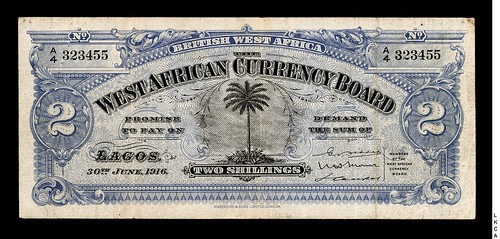
To read the complete lot description, see:
http://www.lynknight.com/ShowAuctionDetails.Asp?auction_Id=277684
Lot 84: Canada 31c/DC-21c 5 Dollars 1.5.1912
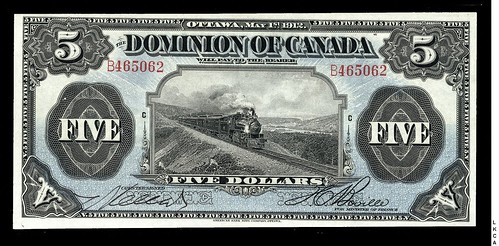
To read the complete lot description, see:
http://www.lynknight.com/ShowAuctionDetails.Asp?auction_Id=277429
Lot 145: Ceylon 52 50 Rupees 12.5.1954
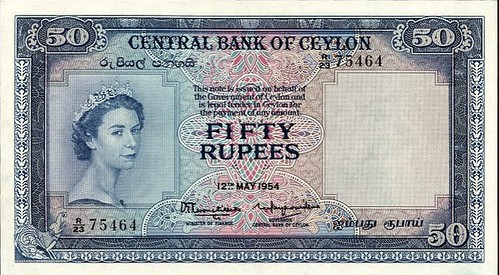
To read the complete lot description, see:
http://www.lynknight.com/ShowAuctionDetails.Asp?auction_Id=275558
Lot 149: Chechnya NL 1 Naxar 1995
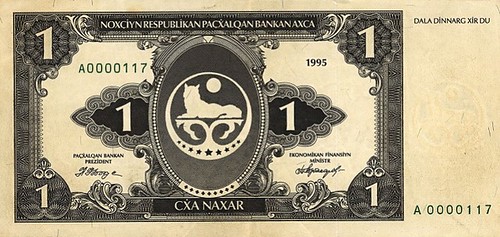
To read the complete lot description, see:
http://www.lynknight.com/ShowAuctionDetails.Asp?Auction_ID=277013
Lot 166: Costa Rica 167 2 Colones 16.9.1935
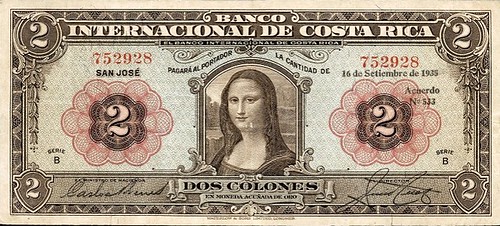
To read the complete lot description, see:
http://www.lynknight.com/ShowAuctionDetails.Asp?auction_Id=276683
Lot 243: Equatorial African States 7 10,000 Francs ND (1968)
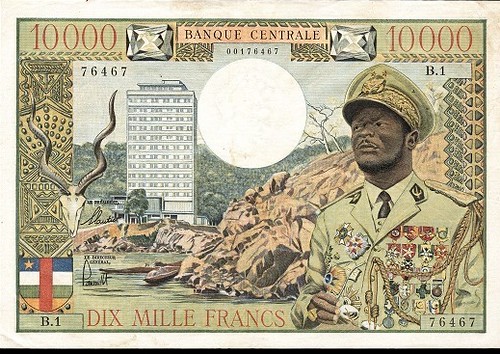
To read the complete lot description, see:
http://www.lynknight.com/ShowAuctionDetails.Asp?auction_Id=275541
Lot 277: France 20 Francs 24.5.1873
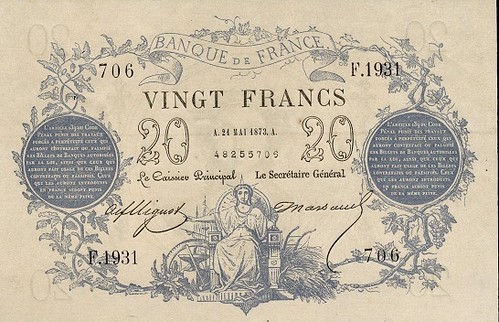
To read the complete lot description, see:
http://www.lynknight.com/ShowAuctionDetails.Asp?auction_Id=277693
Lot 357: India S313 5 Rupees VS1934 (1876)
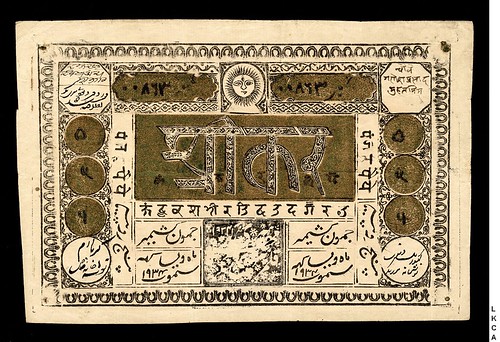
To read the complete lot description, see:
http://www.lynknight.com/ShowAuctionDetails.Asp?auction_Id=275649
Lot 398: Italy 42b 25 Lire 22.1.1919
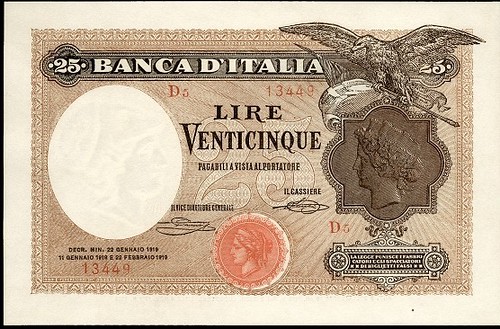
To read the complete lot description, see:
http://www.lynknight.com/ShowAuctionDetails.Asp?auction_Id=277073
Lot 435: Libya 10 Pounds 1.1.1952
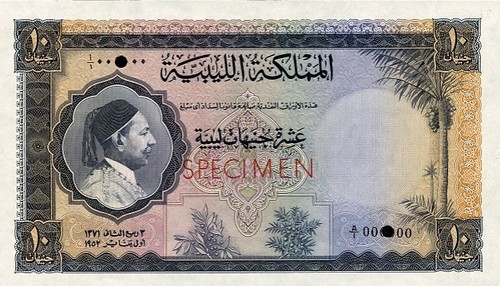
To read the complete lot description, see:
http://www.lynknight.com/ShowAuctionDetails.Asp?auction_Id=276982
Lot 446: Libya M8a 1000 Lire ND (1943)
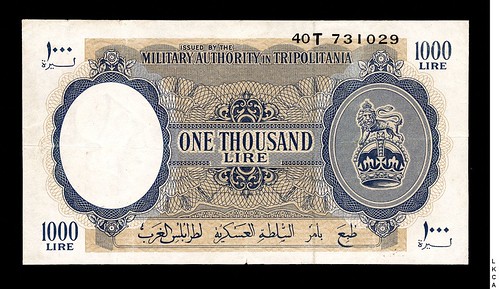
To read the complete lot description, see:
http://www.lynknight.com/ShowAuctionDetails.Asp?auction_Id=277071
Lot 605: Spain 50 Pesetas 19.3.1905
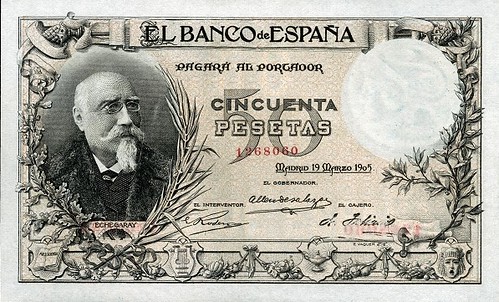
To read the complete lot description, see:
http://www.lynknight.com/ShowAuctionDetails.Asp?auction_Id=275463
Lot 3663: Iran 10,000 Rials AH1317 (1938)
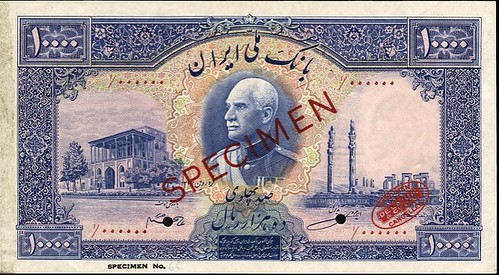
To read the complete lot description, see:
http://www.lynknight.com/ShowAuctionDetails.Asp?auction_Id=278696
Joel Shafer of Lyn Knight Currency Auctions adds:
Our ad in this issue provides a small sampling of the many outstanding pieces included at PCDA. The sale also includes live sessions the following week as follows:
Session 3 Monday, November 21 at 10 AM (Central Time): US Colonial, Confederate, Fractional, Errors, Small Size, Checks, Depression Scrip, Stocks & Bonds, Vignettes
Session 4 Monday, November 21 at 5 PM (Central Time): US MPC, Large Size, Nationals, Obsoletes
Session 5 Tuesday, November 22 at 10 AM (Central Time): World Notes letters A-H
Session 6 Tuesday, November 22 at 5 PM (Central Time): World Notes letters I-Z and Miscellaneous

THE ROYAL MINT'S NEW 12-SIDED £1 COIN
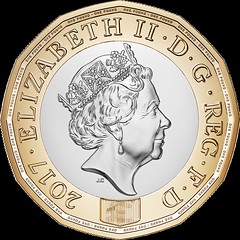
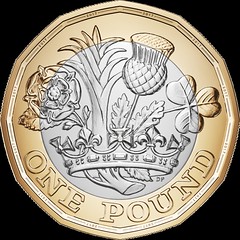
Last week David Sundman forwarded this link (www.thenewpoundcoin.com) noting, "I think this could be the first time a coin has an entire website dedicated to it!" Well, it's an important coin, the Royal Mint's new one pound coin.
In my time living and working in London several years ago, I noted that the pound coin was the workhorse denomination, very heavily circulated. I rarely saw new-looking pound coins in circulation and remarked that it might be an opportunity for counterfeiters to imitate the worn-looknig high-value coins.
I soon saw articles and studies confirming my suspicions - a good percentage of the pound coins were fakes. The Royal Mint embarked on a years-long effort to redesign the old "round pound" and make it harder to fake. The new 12-sided pound is the result of those efforts - a high-quality, high-tech modern coin with multiple anti-counterfeiting features, some usually seen only on paper money.
Here are some excerpts from the site. -Editor
THE MOST SECURE COIN IN THE WORLD
The new coin has a number of features that make it much more difficult to counterfeit.
12-sided – its distinctive shape makes it instantly recognisable, even by touch.
Bimetallic – it is made of two metals. The outer ring is gold coloured (nickel-brass) and the inner ring is silver coloured (nickel-plated alloy).
Latent image – it has an image like a hologram that changes from a ‘£’ symbol to the number '1' when the coin is seen from different angles.
Micro-lettering – it has very small lettering on the lower inside rim on both sides of the coin. One pound on the obverse “heads” side and the year of production on the reverse “tails” side, for example 2016 or 2017.
Milled edges – it has grooves on alternate sides.
Hidden high security feature – a high security feature is built into the coin to protect it from counterfeiting in the future.
STATE-OF-THE-ART
The coin’s design reflects the United Kingdom’s heritage and superb craftsmanship.
Made by The Royal Mint – the coin is produced by The Royal Mint using cutting-edge technology developed on its site in South Wales.
Bold new design – it also features a new design that shows the English rose, the Welsh leek, the Scottish thistle and the Northern Irish shamrock emerging from one stem within a royal coronet. This was created by David Pearce who won a public design competition at the age of 15.
The fifth coinage portrait – the fifth coin portrait of Her Majesty the Queen, designed by Royal Mint coin designer Jody Clark, is featured on the coin.
CHANGING DIMENSIONS
The new 12-sided £1 coin’s dimensions are different from the current round £1 coin.
Thickness: 2.8mm – it is thinner than the round £1 coin.
Weight: 8.75 – it is lighter than the round £1 coin.
Diameter: 23.43mm – it is slightly larger than the round £1 coin, the maximum diameter (point to point) is 23.43mm.
WHY REPLACE THE £1 COIN?
The current £1 coin is being replaced for the first time in over thirty years because of its vulnerability to sophisticated counterfeiters.
Approximately one in thirty £1 coins in circulation is a counterfeit.
That is why we are introducing a new, highly secure coin in March 2017 to reduce the costs of counterfeits to businesses and the taxpayer.
To visit the new pound web site, see:
www.thenewpoundcoin.com
NEW £1 COIN PROMPTS VENDING MACHINE UPDATES
 British businesses are trying to square (or to be precise, polygon) a circle as they get ready for the new pound coin.
British businesses are trying to square (or to be precise, polygon) a circle as they get ready for the new pound coin.
The shiny 12-sided piece will start circulating in March, gradually replacing the existing round coins.
The old pound will be phased out by next fall because its design makes it vulnerable to counterfeiting. The Royal Mint said more than 2.5% of all £1 coins currently in circulation -- approximately 1 in 40 -- are fake.
The new pound is being hailed by the Royal Mint as the most secure coin in the world. It even boasts a hidden high-security feature that will protect it against counterfeiting, the mint said.
But it is also causing some businesses a headache. Because of its shape, and because its different metal composition gives it a different weight, it will not fit most existing vending machines, lockers and shopping carts.
They will have to be updated, and that will not come cheap. The Automatic Vending Association estimates it will cost the industry £32 million to make sure the 500,000 vending machines across the U.K. are ready to accept the new coin.
To read the complete article, see:
More than 500,000 vending machines need update
(www.texomashomepage.com/news/britains-new-pound-coin-wont-fit-into-vending-machines)

CHINA TO WITHDRAW 1 JIAO COINS
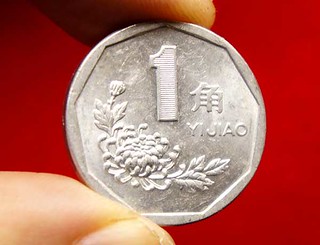 One series of the 1 jiao coin (0.15 cents) was to be removed from circulation starting on Tuesday, making the coin more valuable for collectors, according to a report by Modern Express.
One series of the 1 jiao coin (0.15 cents) was to be removed from circulation starting on Tuesday, making the coin more valuable for collectors, according to a report by Modern Express.
People's Bank of China, the central bank, has called on banks nationwide to hand over all that series of 1 jiao coins, adding that no new such coins are to be distributed, the newspaper reported.
The coin, minted mainly from 1991 to 1999, is among the fourth series of renminbi coins. It features a chrysanthemum on one side and the National Emblem of the People's Republic of China, the full title of the state in Chinese and pinyin on the other side.
The fourth series of notes were introduced in denominations of 0.1, 0.2, 0.5, 1, 2, 5, 10, 50 and 100 yuan. Coins were introduced in denominations of 0.1, 0.5 and 1 yuan.
The report cited a collector as saying that the coin is favored by collectors because of its design, which features nonagon inside edges on both sides of the coin.
"A 1994 edition of the coin is worth about 30 yuan, while a set of nine coins from 1991 to 1999 is worth about 200 yuan," the collector said.
The coin was also minted in 2000, but that edition was never distributed to the public. It was only included in a collection album and is said to worth about 1,000 yuan.
To read the complete article, see:
Central bank to remove 1 jiao coin series
(http://wap.chinadaily.com.cn/2016-11/02/content_27246134.htm)
INDIA SCRAPS 500 AND 1,000 RUPEE BANKNOTES
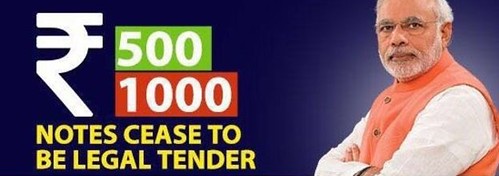
Indian Prime Minister Narendra Modi has announced that the 500 ($7.60) and 1,000 rupee banknotes will be withdrawn from the financial system overnight.
The surprise move, announced on Tuesday evening, is part of a crackdown on corruption and illegal cash holdings. Banks will be closed on Wednesday and ATM machines will not be working.
India is overwhelmingly a cash economy. New 500 and 2,000 rupee denomination notes will be issued to replace those removed from circulation.
"Black money and corruption are the biggest obstacles in eradicating poverty," Mr Modi said.
People will be able to exchange their old notes for new ones at banks over the next 50 days but they will no longer be legal tender.
The announcement prompted people across the country to rush to ATMs that offer 100 rupee notes in an attempt not to be left without cash over the next few days.
Government guidelines say it is possible to exchange 4,000 rupees - but it is not clear if this is per day or in total. Critics say the new rules may make it especially difficult for people who choose to keep their cash at home rather than in a bank account and for people with large rupee cash reserves who live abroad.
If there is a legitimate explanation for the cash, the authorities say, it will be possible to exchange it.
To read the complete article, see:
India scraps 500 and 1,000 rupee bank notes overnight
(www.bbc.com/news/business-37906742)
When Prime Minister Narendra Modi announced on prime time TV Tuesday that bank notes making up almost 90% of the value of currency circulating in Asia’s third-largest economy would become worthless paper within hours, he stunned a cash-loving nation.
He also drove bankers back to the office.
“It was like watching a bomb drop,” said Rajnish Kumar, a managing director at State Bank of India Ltd., whose job includes running the network of branches and ATMs at the country’s largest lender. “I rushed back to the bank and set up the war room.”
To read the complete article (subscription required), see:
Banks and Businesses Rush to Adapt as India Moves to Replace Notes
(www.wsj.com/articles/banks-and-businesses-rush-to-adapt-as-india-moves-to-replace-notes-1478700967)
RUPEE BANKNOTE BAN CAUSES PANIC
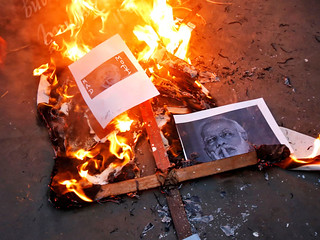 A woman who feared she would be left broke after hearing 500 and 1,000 rupee notes were being withdrawn from circulation in India has killed herself, police have said.
A woman who feared she would be left broke after hearing 500 and 1,000 rupee notes were being withdrawn from circulation in India has killed herself, police have said.
Kandukuri Vinoda, 55, had a large amount of the high denomination notes at home and apparently panicked, thinking her savings had become worthless.
Ms Vinoda, from Mahabubabad district, east of Hyderabad city, had been paid around 5.5 million rupees (£65,000) in cash after selling land last month.
The country's prime minister Narendra Modi announced on Tuesday that the 500 (£6) and 1,000 (£12) rupee notes were being pulled nationwide in a crackdown on "black money".
It has also caused chaos at banks, with long queues forming and arguments breaking out.
Thousands of police were called to help control the situation.
People tried to swap the worthless cash for smaller bills or new 2,000 rupee notes being rushed into circulation, and ATMs were shut.
The price of fresh fruit and vegetables dropped sharply as people ran out of cash, and vendors were unable to give change to those who did.
The government has told hospitals and petrol stations to accept the old money for a few more days.
Meanwhile, police in Uttar Pradesh state said they were investigating reports people were burning sacks of the defunct notes so they did not have to declare them, thus avoiding heavy penalties.
To read the complete article, see:
'Panicked' woman kills herself over rupee bank note ban in India
(http://news.sky.com/story/panicked-woman-kills-herself-over-rupee-bank-note-ban-in-india-10652636)
NEW INDIAN BANKNOTES PRINTED IN SECRET
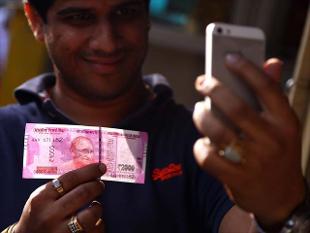 The high-value Rs 2,000 notes, introduced by Prime Minister Narendra Modi to replace Rs 1,000 notes to flush out black money, were largely printed at Mysuru under utmost secrecy while the paper note on which the printing was done came from Italy, Germany and London. The government printing press facility at Dewas, Nasik and Salboni in West Bengal were not utilised in the initial phase, according to government sources.
The high-value Rs 2,000 notes, introduced by Prime Minister Narendra Modi to replace Rs 1,000 notes to flush out black money, were largely printed at Mysuru under utmost secrecy while the paper note on which the printing was done came from Italy, Germany and London. The government printing press facility at Dewas, Nasik and Salboni in West Bengal were not utilised in the initial phase, according to government sources.
The printing, according to officials, began in August-September and nearly 480 million notes of Rs 2,000 denomination and an equal number of Rs 500 denomination were printed. The printing facility at Bharatiya Reserve Bank Note Mudran Private Ltd. (BRBNMPL) in Mysuru under Reserve Bank of India was set up with the De La Rue Giori, now KBA Giori, Switzerland. A similar facility has been developed at Salboni by Komori Corporation, Japan, said officials.
A senior government official on the condition of anonymity said, "The printing at other government presses will start soon. The bank note mills set up at Mysuru and Hoshangabad in Madhya Pradesh will be able to meet 70% of domestic currency demand in coming days. However, we are concerned with the capping on withdrawal of Rs 2000 per day up to November 18, 2016 and it is expected to lead to chaos at ATMs."
To read the complete article, see:
Printing of Rs 2,000 banknotes began in Aug-Sept in Mysuru
(http://economictimes.indiatimes.com/news/economy/policy/printing-of-rs-2000-banknotes-began-in-aug-sept-in-mysuru/articleshow/55368130.cms)
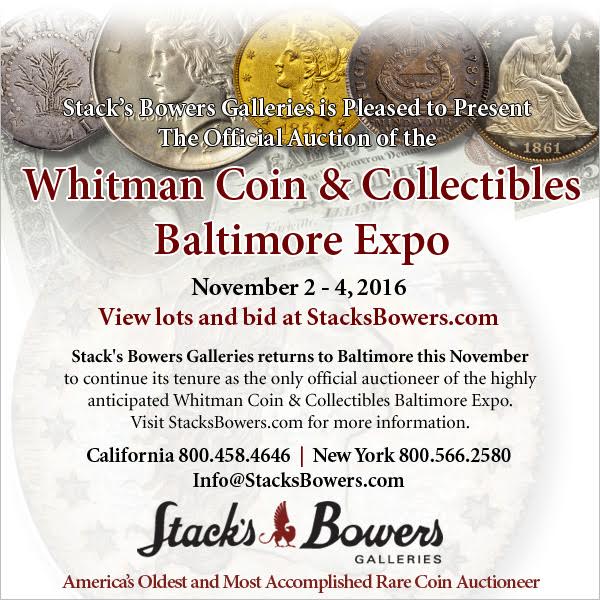
NUMISMATISTS SCRAMBLE FOR DEMONETIZED RUPEES
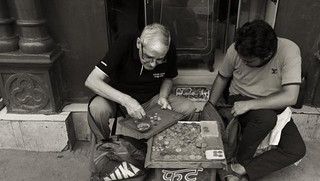 With the Centre demonetising Rs 500 and Rs 1000 notes on Tuesday, numismatists in Kolkata are sniffing an opportunity to cash in on this change. The city’s coin collectors have started collecting Rs 500 and Rs 1,000 notes of various series as these could fetch antique value in future.
With the Centre demonetising Rs 500 and Rs 1000 notes on Tuesday, numismatists in Kolkata are sniffing an opportunity to cash in on this change. The city’s coin collectors have started collecting Rs 500 and Rs 1,000 notes of various series as these could fetch antique value in future.
“If you remember, notes of Rs 1000, Rs 5000 and Rs 10,000 denominations were demonetized by the government in 1978. One such Rs 10,000 note was recently sold in an auction at Mumbai for Rs 10 lakhs because of its antique value,” said Sandip Kumar Singhvi, the only dealer in the city to hold an Archaeological Survey of India’s license to deal with antique coins and notes.
“The present denominations scrapped by the government would also become antiques in the future and could be sought after by coin collectors,” Singhvi told HT.
The highest currency note ever printed by the Reserve Bank of India (RBI) was Rs 10,000 note during the British Raj. It was printed first in 1938 and a new version came in 1954. But those were demonetized in January 1946 and again in January 1978 when the Morarji Desai government came in power.
“We have already started collecting Rs 500 and Rs 1,000 notes of various series and signed by various governors. The early series notes carrying the signatures of former RBI governors such as Bimal Jalan and R N Malhotra are rare and fetch good price. As these notes have now been scrapped, they would now become antique and fetch good return in the future,” said Ravishankar Sharma, former secretary of the Numismatics Society of Kolkata.
Numismatists usually refer to a book – Phila India Paper Money Guidebook – authored by Manik Jain to find out the various series of notes and by which RBI governor it has been signed. The last book was published in 2015 and the next one is expected in December 2016.
To read the complete article, see:
Numismatists to preserve Rs 500, Rs 1000 samples for antique value in future
(www.hindustantimes.com/kolkata/numismatists-to-preserve-rs-500-rs-1000-samples-for-antique-value-in-future/story-dviNYYXdx1vdRINc4otw0I.html)
To read the complete article, see:
HOW HOWARD DANIEL GOT MPCS WHOLESALE
(www.coinbooks.org/esylum_v19n18a25.html)
VENEZUELA HIRES CRANE CURRENCY FOR NEW NOTES
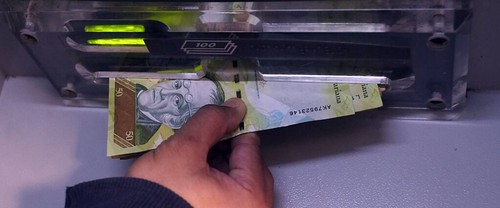
Venezuela’s Socialist government, a vocal critic of the dollar’s global dominance, has hired the exclusive supplier of U.S. currency paper to provide the bulk of its new bank notes.
Earlier this month, Venezuela’s central bank awarded Boston-based securities printer Crane Currency the largest part of a contract for new bill denominations needed to keep up with triple-digit inflation, according to people involved in contract negotiations.
“Given their antipathy towards the U.S., I’m surprised that they would even let a U.S. firm participate,” said Owen Linzmayer, a San Francisco-based banknote expert who catalogs world currencies.
The central bank and Crane, which has provided the U.S. Treasury with blank currency paper since the 1879, declined to comment.
As inflation soars, the bills in circulation across Venezuela are nearly worthless, turning the most basic transactions into logistical nightmares and saddling local banks with crippling money-handling costs. ATMs run out of cash in just a few hours and coins have little to no use in a country afflicted by a deep economic contraction and rising political turmoil.
Struggling with runaway inflation, Venezuela’s central bank chose several companies, including Crane and U.K.-based De La Rue. The firms will deliver new notes going up to 20,000 bolivars in December. At present, the biggest note in use is the 100-bolivar bill, which is worth eight cents on the black market.
To read the complete article (subscription required), see:
Inflation-Racked Venezuela Turns to Company Behind U.S. Dollars for New Bills
(www.wsj.com/articles/inflation-racked-venezuela-turns-to-company-behind-u-s-dollars-for-new-bills-1477941766)
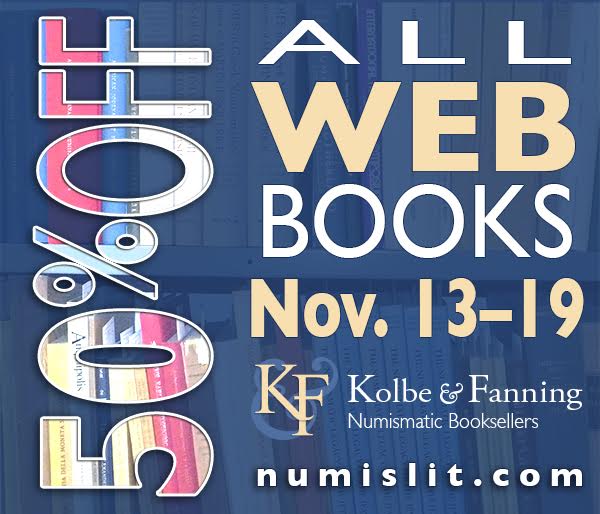
GEORGIA RELEASES NEW 100 LARI BANKNOTES
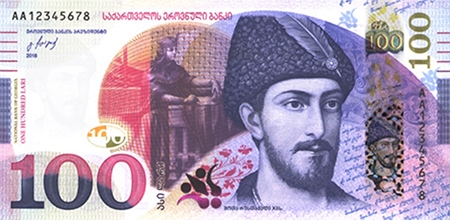
Modernised 100 GEL (Georgian Lari) banknotes in bright new colours and sizes is coming into circulation today around the country.
Meanwhile updated 20 and 50 GEL notes were released in February and all new banknotes currently circulate alongside the old notes.
Extra high-tech security features were added to the new banknotes, making them better protected from fraudulent copying. The bills were also of better quality and had special improved features for visually impaired people.
The National Bank of Georgia (NBG) said the new money depicted the same iconic faces but had a vastly different and more vibrant look with additional elements.
To read the complete article, see:
Georgia’s new 100 Lari banknotes released today
(http://agenda.ge/news/69100/eng)
FAKE EURO NOTES FOUND IN BULGARIAN RESERVOIR
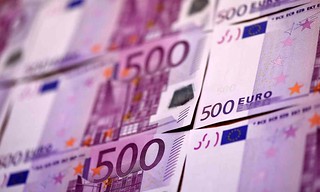 Scuba divers have found an estimated €13m (£11.7m) in fake notes in a Bulgarian reservoir during a police operation, which authorities say is a record haul.
Scuba divers have found an estimated €13m (£11.7m) in fake notes in a Bulgarian reservoir during a police operation, which authorities say is a record haul.
The seizure of the counterfeit €500 notes, most of which had been stashed underwater near a dam in the south of the country, was made after police were told they would be imminently entering circulation, said Bulgaria’s chief prosecutor, Sotir Tsatsarov.
“This is one of the largest amounts of counterfeit euros ever encountered,” he told journalists in Plovdiv, after one of the counterfeiters confessed and led authorities to the hiding place.
The exact value of the haul will be established after the notes are dried and counted, said the Plovdiv appeal prosecutor, Ivan Daskalov.
Three Bulgarians were arrested in connection with the case, including the owner of a printing company who has already been sentenced to six years for counterfeiting money, officials said.
Earlier this year, the European Central Bank decided to stop issuing €500 notes from the end of 2018 on the grounds that they are favoured by criminals for money laundering and sometimes financing terrorism.
However, those currently in circulation will remain legal tender.
To read the complete article, see:
Divers find estimated €13m in fake notes in Bulgarian reservoir
(www.theguardian.com/world/2016/nov/01/bulgaria-divers-find-haul-counterfeit-500-euro-notes-reservoir-police-operation)
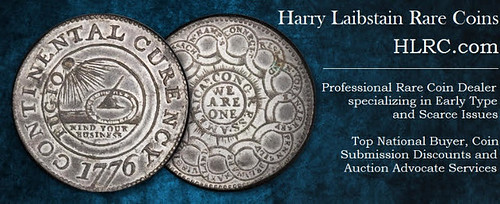
NEW BOOK: THE CURSE OF CASH
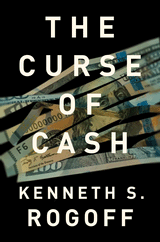 The Curse of Cash
The Curse of Cash
Kenneth S. Rogoff
Hardcover | 2016 | $29.95 | £22.95 | ISBN: 9780691172132 296 pp. | 6 x 9 | 30 line illus
The world is drowning in cash—and it’s making us poorer and less safe. In The Curse of Cash, Kenneth Rogoff, one of the world’s leading economists, makes a persuasive and fascinating case for an idea that until recently would have seemed outlandish: getting rid of most paper money.
Even as people in advanced economies are using less paper money, there is more cash in circulation—a record $1.4 trillion in U.S. dollars alone, or $4,200 for every American, mostly in $100 bills. And the United States is hardly exceptional. So what is all that cash being used for? The answer is simple: a large part is feeding tax evasion, corruption, terrorism, the drug trade, human trafficking, and the rest of a massive global underground economy.
As Rogoff shows, paper money can also cripple monetary policy. In the aftermath of the recent financial crisis, central banks have been unable to stimulate growth and inflation by cutting interest rates significantly below zero for fear that it would drive investors to abandon treasury bills and stockpile cash. This constraint has paralyzed monetary policy in virtually every advanced economy, and is likely to be a recurring problem in the future.
The Curse of Cash offers a plan for phasing out most paper money—while leaving small-denomination bills and coins in circulation indefinitely—and addresses the issues the transition will pose, ranging from fears about privacy and price stability to the need to provide subsidized debit cards for the poor.
While phasing out the bulk of paper money will hardly solve the world’s problems, it would be a significant step toward addressing a surprising number of very big ones. Provocative, engaging, and backed by compelling original arguments and evidence, The Curse of Cash is certain to spark widespread debate.
Kenneth S. Rogoff, the Thomas D. Cabot Professor of Public Policy at Harvard University and former chief economist of the International Monetary Fund, is the coauthor of the New York Times bestseller This Time Is Different: Eight Centuries of Financial Folly (Princeton). He appears frequently in the national media and writes a monthly newspaper column that is syndicated in more than fifty countries. He lives in Cambridge, Massachusetts.
For more information, or to register, see:
Kenneth Rogoff on "The Curse of Cash"
(www.moaf.org/events/general/evt_20161130)
For more information, or to order:
The Curse of Cash
(http://press.princeton.edu/titles/10798.html)
THE HISTORY OF BOOK CURSES
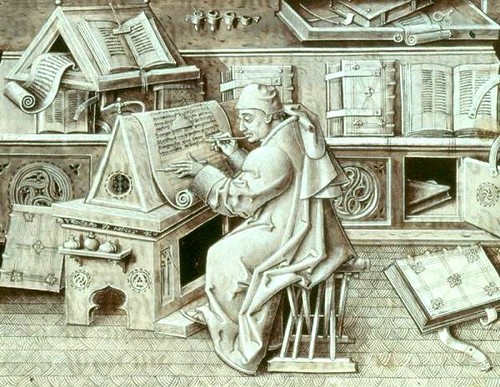
In the Middle Ages, creating a book could take years. A scribe would bend over his copy table, illuminated only by natural light—candles were too big a risk to the books—and spend hours each day forming letters, by hand, careful never to make an error. To be a copyist, wrote one scribe, was painful: “It extinguishes the light from the eyes, it bends the back, it crushes the viscera and the ribs, it brings forth pain to the kidneys, and weariness to the whole body.”
Given the extreme effort that went into creating books, scribes and book owners had a real incentive to protect their work. They used the only power they had: words. At the beginning or the end of books, scribes and book owners would write dramatic curses threatening thieves with pain and suffering if they were to steal or damage these treasures.
They did not hesitate to use the worst punishments they knew—excommunication from the church and horrible, painful death. Steal a book, and you might be cleft by a demon sword, forced to sacrifice your hands, have your eyes gouged out, or end in the “fires of hell and brimstone.”
“These curses were the only things that protected the books,” says Marc Drogin, author of Anathema! Medieval Scribes and the History of Book Curses. “Luckily, it was in a time where people believed in them. If you ripped out a page, you were going to die in agony. You didn’t want to take the chance.”
Drogin’s book, published in 1983, is the most through compendium of book curses ever compiled. A cartoonist and business card designer, Drogin had taken an adult-education class in Gothic letters and became entranced with medieval calligraphy. While researching his first book, he came across a short book curse; as he found more and more, hidden in footnotes of history books written in the 19th century, his collection grew to include curses from ancient Greece and the library of Babylon, up to the Renaissance.
“For him that stealeth, or borroweth and returneth not, this book from its owner, let it change into a serpent in his hand & rend him. Let him be struck with palsy & all his members blasted. Let him languish in pain crying aloud for mercy, & let there be no surcease to his agony till he sing in dissolution. Let bookworms gnaw his entrails in token of the Worm that dieth not, & when at last he goeth to his final punishment, let the flames of Hell consume him for ever.”
To read the complete article, see:
Protect Your Library the Medieval Way, With Horrifying Book Curses
(www.atlasobscura.com/articles/protect-your-library-the-medieval-way-with-horrifying-book-curses)

ARTIST JOHNNY SWING'S PENNY CHAIR
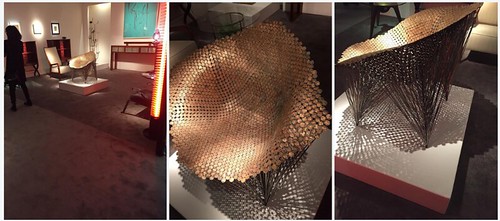
Tony adds:
To read the earlier E-Sylum articles, see:
JOHNNY SWING'S COIN FURNITURE
(www.coinbooks.org/esylum_v13n13a24.html)
VERMONT ARTIST CREATES FURNITURE USING COINS
(www.coinbooks.org/esylum_v14n17a25.html)
COOL BAR TRICK WITH NICKEL AND MATCHSTICK
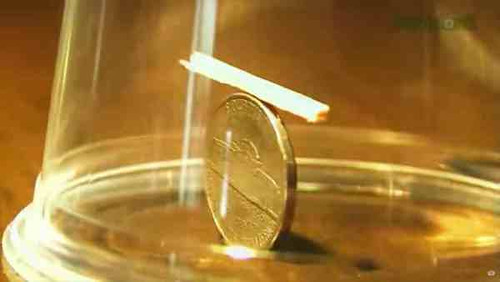
To watch the video, see:
Bar trick - remove the matchstick balanced on a nickel under a glass without touching anything
(http://boingboing.net/2016/11/11/bar-trick-remove-the-matchst.html)
FEATURED WEB SITE: BANS
This week's Featured Web Site is the British Association of Numismatic Societies (BANS).
The British Association of Numismatic Societies is the national organisation which represents numismatic societies throughout the United Kingdom. It exists to promote the study of numismatics by bringing these societies and their members together to share and increase their interest and expertise in coins, tokens and currency.
What else does BANS do?
BANS holds an annual weekend congress, organised by the local numismatic society, in a different attractive place each year.
BANS runs an annual autumn lecture course, with a more specifically educational programme. As at the congresses, the lectures are given by the leading museum, trade and amateur experts.
BANS has published a series of booklets; these are available from numismatic book dealers. See ' BANS Publications'.
BANS has produced videotapes of lectures by prominent numismatists.
BANS hires out sets of slides on popular coin series at modest cost to affiliated societies.
BANS has funds available to help young members of affiliated societies to attend its weekend meetings and to obtain books.

www.coinclubs.org.uk

